Probably also due to its everchanging, turbulent history, Berlin is still a bit rough around its edges and this is also reflected in its Street Art scene – which is arguably one of the best in all of Europe if not in the entire world.
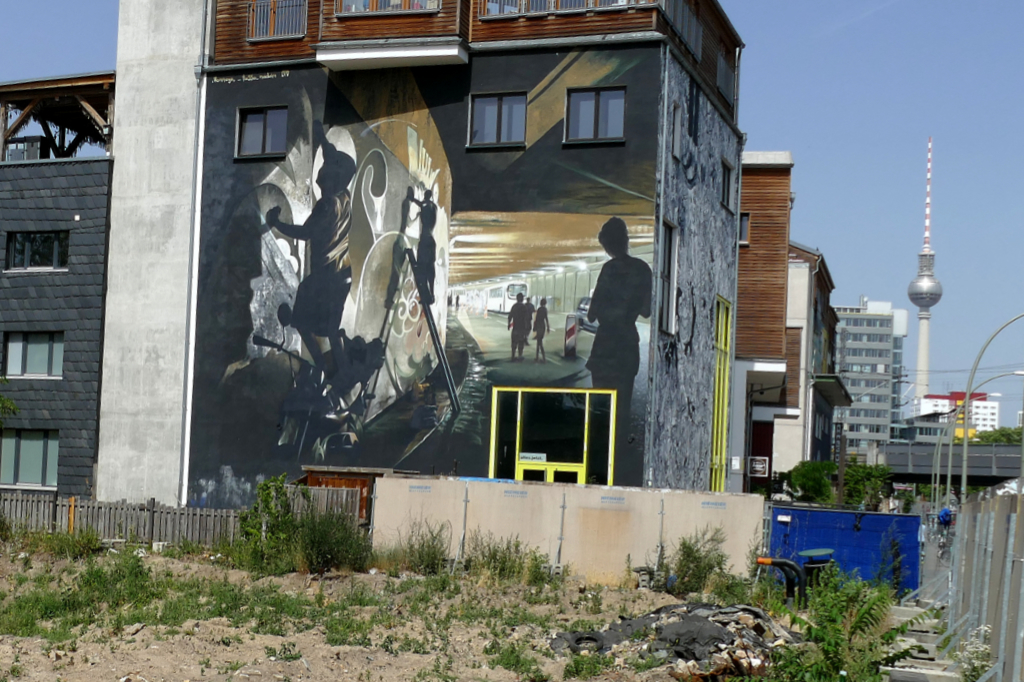
So, put on your most comfortable shoes, polish you’re camera’s lens, and let’s explore all those grand murals that are embellishing the walls of Germany’s exhilarating capital
Street Art
There aren’t just a couple of keywords that can define street art in all its shapes and forms. As a matter of fact, the art of sketching and painting on walls goes way back to the cavemen, to the era of the Pyramids in Giza, as well as the Roman Empire.
Then, the contemporary graffiti movement started in the 1960s as a claim of urban territory by gangs as well as a response to the political and social injustice going on around the world. Graffiti developed from the so-called tagging, hence writing names’n’slogans in a more or less artsy way.
On the other hand, today’s larger than life wall-paintings have their roots rather in murals from Latin America. The most famous muralist was probably Frida Kahlo’s husband Diego Rivera. Albeit, he rather depicted and honored the Indigenous heritage and culture than face social problems and protests.
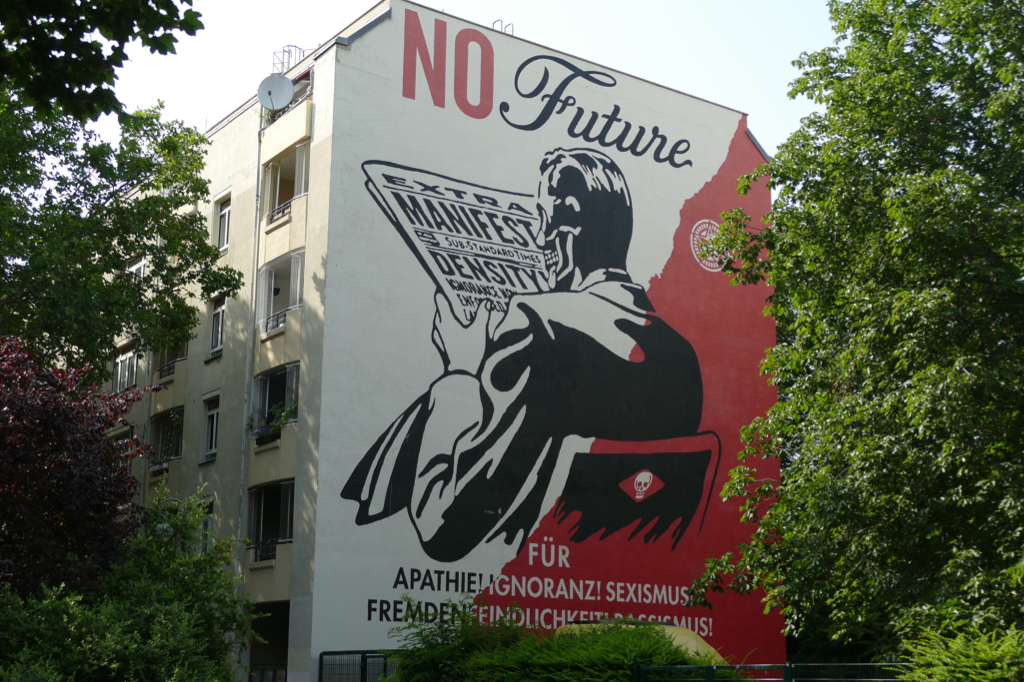
Yet, you can often spot a rebellious undertone in urban art. Maybe it’s because you’ll find it frequently on abandoned buildings, objects of capitalist speculation in urban areas. While graffiti and murals in run-down neighborhoods depict social problems, in other areas, some pointless smearing is simply vandalism. This difference is sometimes a very thin line and leaves much room for interpretation – as well as heated discussions and legal consequences.
Uncensored Canvases
However, let’s be real here – over the past decades, street art is not only going but actually racing towards the mainstream since hip galleries and posh art lovers are adding works by famous street artists to their collections.
Hence, the first Street Art Museum opened in Berlin already back in 2017.
Private house owners, communities, as well as local governments, commission artists to decorate designated walls’n’structures. Obviously, tourist tours around the globe include often also street art.
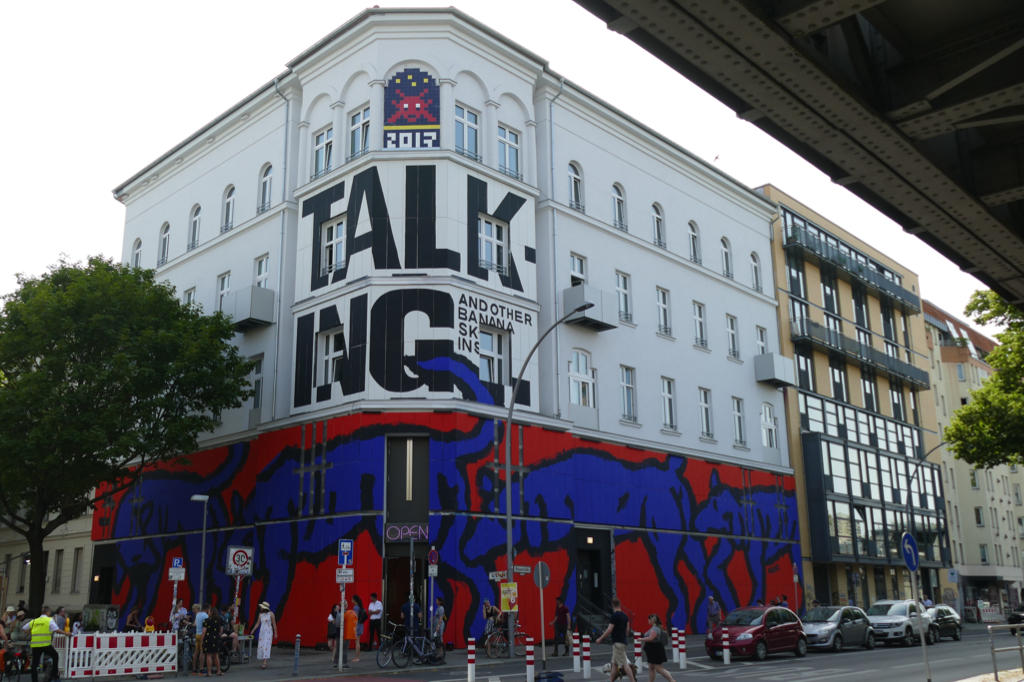
This is certainly not the spirit of rough’n’revolutionary urban art. However, it is a development that actually helped many artists. Illegal spraying and painting got lifted up to an accepted form of culture. Here, too, it is a pretty thin line – but maybe it’s exactly this controversy that keeps urban art interesting and inspiring and – alive.
In many places like for instance Singapore, George Town, Rio de Janeiro, and most recently Málaga, I’ve seen beautiful murals. Many of those were commissioned either by the city or by private sponsors. That without any doubt is wonderful for the urban artists. However, you notice the difference. Most of the time, those paintings are simply not as rough’n’raw as street art on crumbling walls and abandoned buildings.
Berlin, however, has a good mix of both.
Berlin
Street art came to Berlin way back in the 1970s. The subcultures of punk and hip hop left their traces in the streets of the then still divided city. At the same time, the graffiti scene that had developed in New York’s underground swept across Europe.
Initially, marginalized groups such as punks, squatters, and political activists banned their subversive art on the streets of West Berlin.
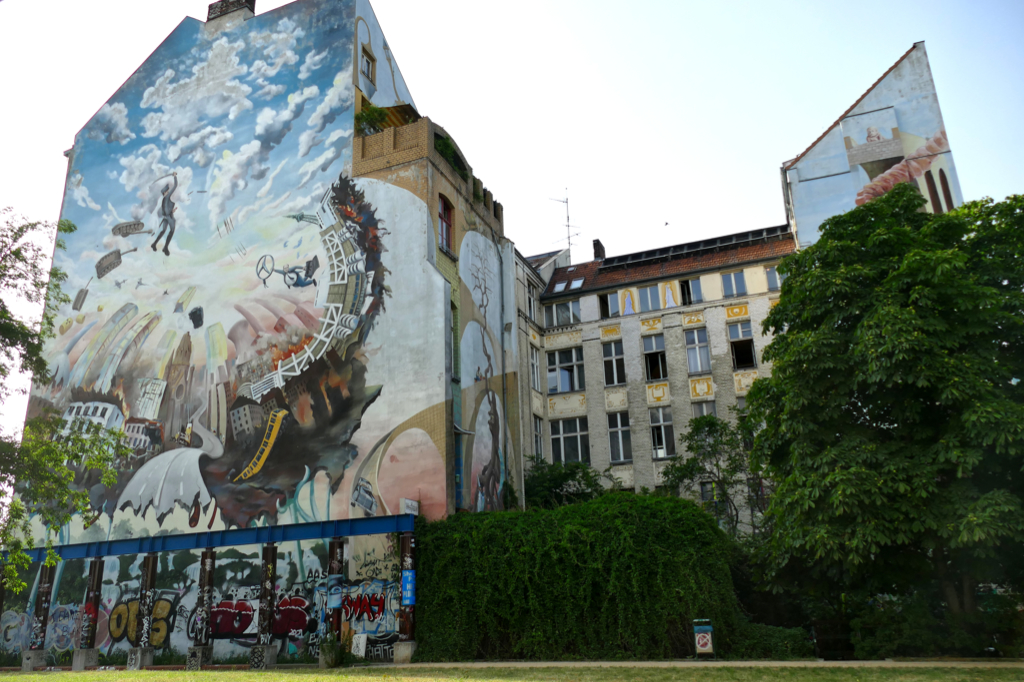
At the end of the 1970s, interest in street art increased. Numerous artists brought in different styles and techniques. The goal was an active intervention in the cityscape. The works often contained political messages. Many artists painted the western side of the wall that divided Berlin.
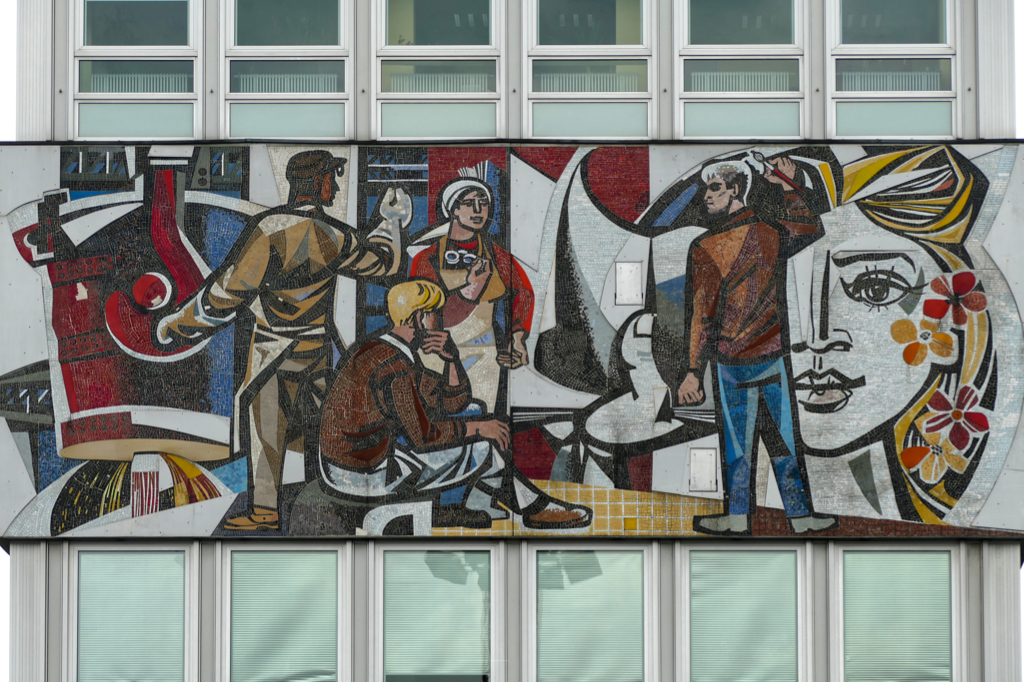
Nevertheless, there were also forms of graffiti and street art in the GDR. For instance, in East Berlin’s district Marzahn, a Nicaraguan artist designed the façades in the 1980s. However, the freedom of artists in the eastern part of the city was severely restricted and had to submit to socialist realism, obviously.
Becoming One
When the Berlin wall came down in 1989, it also ignited a new era of urban art. Artists from West Berlin brought their culture to the East and developed joint projects with the street artists there. In addition, numerous international artists immortalized themselves on the remains of the wall. Today, it is the so-called East Side Gallery. Over the decades, Berlin became not only the capital of Germany, but also the capital of street art. In 2006, UNESCO rewarded Berlin with the City of Design award.
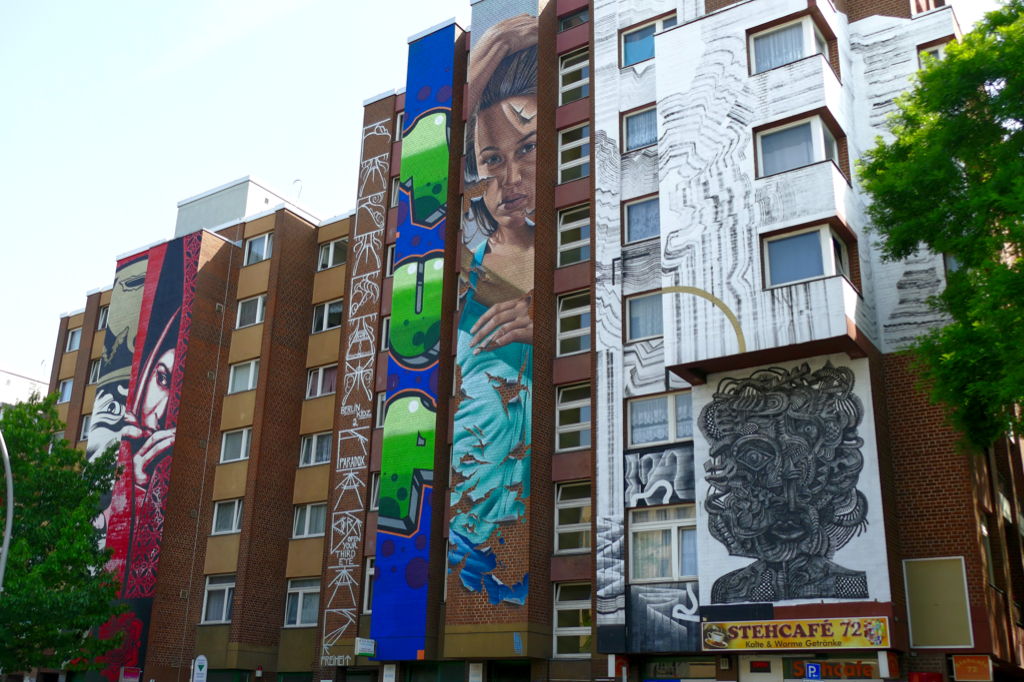
Hence, street art has arrived in the center of cities – literally. Not only die-hard art enthusiasts enjoy those larger-than-life murals. Many tourists include some street art hunting into their itinerary. Architects and house owners explicitly commission street artists to decorate dull walls. However, the proportion of works with political and critical statements is decreasing with increasing commercialization.
Nevertheless, while there are many official and instagrammable murals in the city with contributions from some of the world’s best urban artists, large parts of Berlin are still blatant and rebellious open-air galleries.
Clusters
While in my post on street art in Málaga or Valencia, I’ve listed the works and their creators in alphabetic order, this would be a mess in Berlin. The city is simply far too big. To make it easy for you street art hunters, I’ve divided the works into three hunting grounds. Also, you find the exact spots in the map below. So, good hunting!
Friedrichshain
Friedrichshain is a typical Gründerzeit neighborhood. After the division of Berlin in the aftermath of WWII, Friedrichshain was in the so-called Soviet sector. Hence, from 1949 to 1990, it was part of the eastern part of the city. The area between the river Spree and the artery street Mühlenstraße is now a tourist attraction due to the East Side Gallery.
Holzmarkt
300 years ago, the Holzmarkt was a marketplace for the timber trade. Over the decades, it was a gasworks, a landfill, but also a techno club. Obviously, its location at the border between East and West, it has gone from a no-man’s-land to a sought-after terrain. Today, however, it is an alternative urban project. Managed by an independent cooperative, the Holzmarkt is a playground for locals as well as visitors from all over the world.
And it’s here where my trail of urban art begins.
KlebeBande
KlebeBande, which loosely translates to the Sticky Gang, is an art collective from Berlin.

With great attention to detail, they combine form and color, but also language in their art projects. In their very unique style, they realize room installations as well as large-scale façade designs by combining foil, adhesive strips, and spray cans.
WENU artist collectiv
Next to the Klebebande-mural is a grand work by WENU.
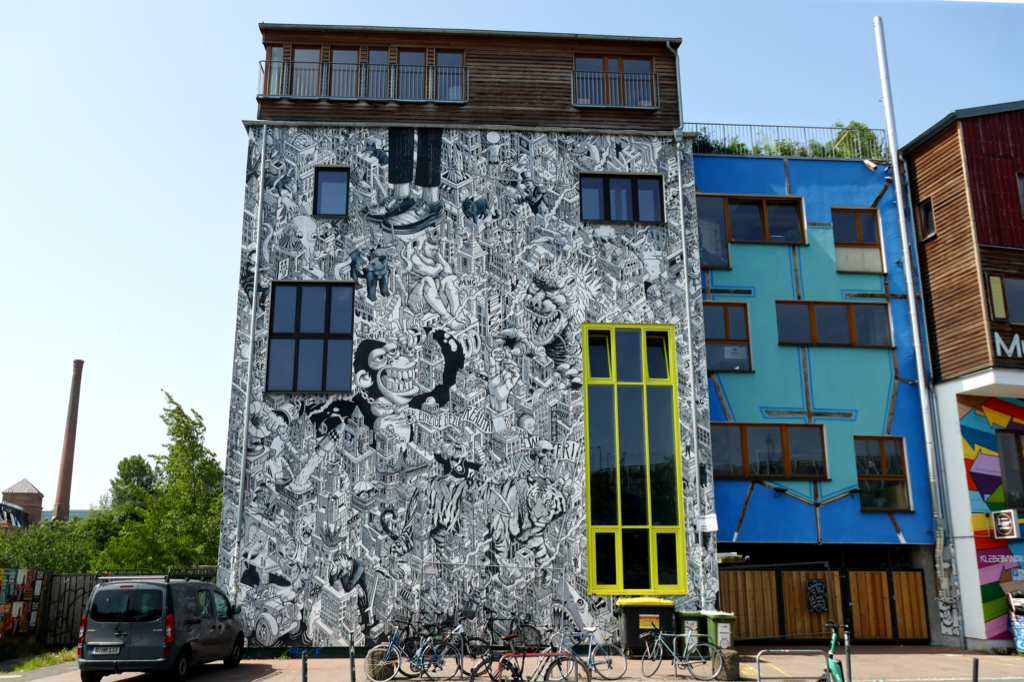
WENU means We and You and was founded by four artists from Hong Kong and Berlin. WENU art project tries to make cities more livable with uniqueness and beauty through their art.
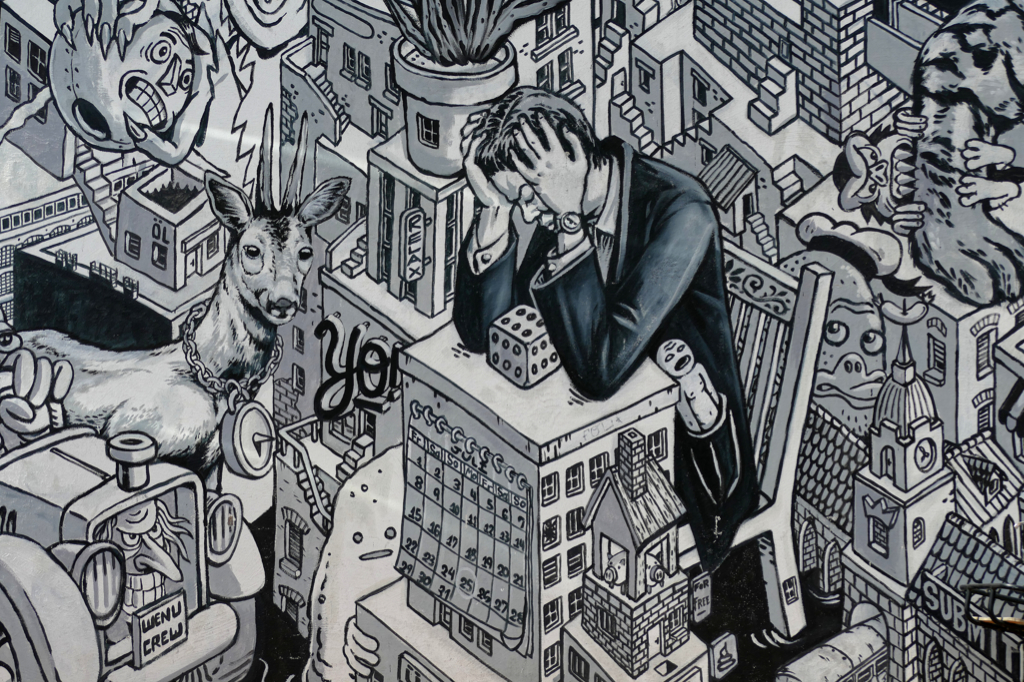
The artist collective has developed an illustrative style in black and white. Your hidden object pictures depict scenes from very different perspectives. This is not only inspiring for the viewer. It also enables the four artists to work together.
Cranio
Like many great muralists, Cranio comes from São Paulo. Cranio’s real name is actually Fabio de Oliveira Parnaiba. His pseudonym, however, translates to skull in Portuguese.
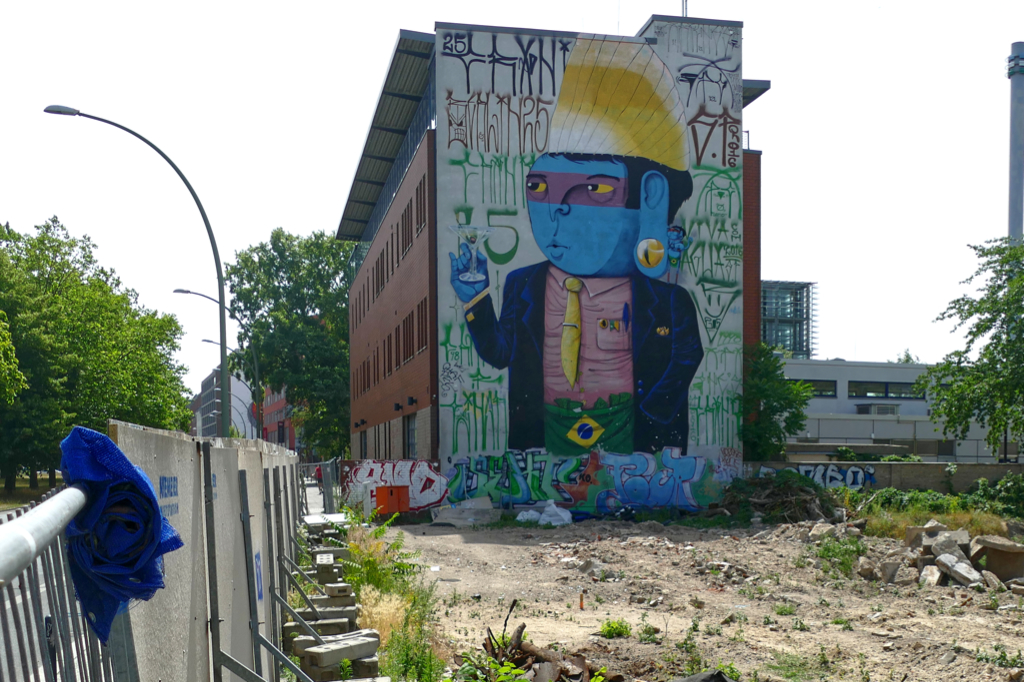
In 1998, he began beautifying the walls of his hometown. Today, you can find his works in many other cities such as Berlin and Hamburg.
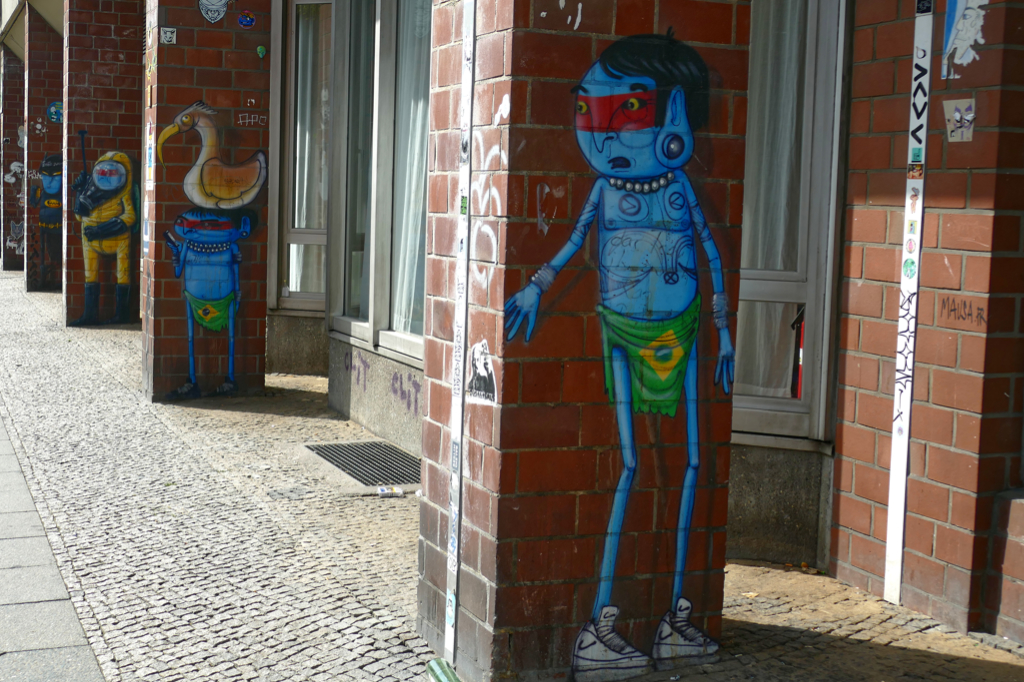
A blue Indian, a representative of Brazil‘s indigenous people, is the artist’s trademark. Although Cranio’s Indians appear cheerful and comic-like, they should point out problems such as consumption, corruption, and environmental degradation.
YAAM
As you continue south, you’ll get to another culture and foodie site, namely YAAM.
YAAM, an abbreviation for Young African Art Market, is located directly on the river Spree. Here you can relax in an urban tropical setting. The music often comes from live bands. At the YAAM, locals and visitors come together for an instant vacation.
Obviously, there is also some very cool urban art at the YAAM. My absolute favorite mural is a portrait by VHILS.
VHILS
VHILS is an artist from Portugal whose real name is Alexandre Farto.
His artistic approach is actually rather destructive: Instead of painting walls, he carves, drills, and blasts off layers of the surface.
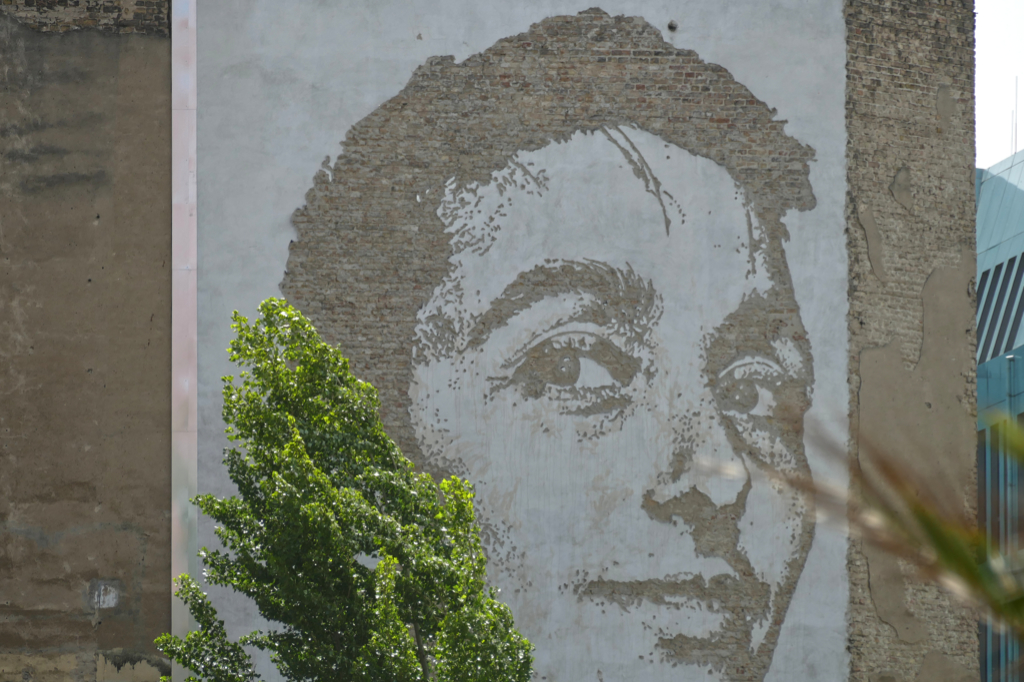
VHILS has experimented with different media to advance the technique and aesthetics of his art.
The next stop on my urban art tour is the legendary East Side Gallery. Since it’s only about one kilometer east of the YAAM, you can walk there in about ten minutes. However, if you’re tired of walking, bus #300 takes you there in about the same amount of time.
East Side Gallery
The East Side Gallery is not only an open-air gallery but also a memorial. After all, it’s the longest surviving section of the former wall.
118 artists from 21 countries began to paint the wall in the spring of 1990. The total length of this stony canvas was 1316 meters.
The artists commented on the political changes of 1989 respectively 1990. It was the era right after the opening of the border between the two Germanies. About one hundred paintings are decorating the side of the wall that faces the former East.
Due to urban planning measures, it is no longer preserved in its entirety. Also, what you see today is not the originals.
Deterioration
Over the years, many of the East Side Gallery’s paintings have been badly weathered. The works are particularly damaged by the weather and sadly also graffiti. While some pictures disappeared completely, new pieces were added.
In 1996, the association Künstlerinitiative East Side Gallery was founded. They have been trying to preserve and rehabilitate the gallery ever since. With the support of the paint industry association, 40 of the severely attacked paintings were restored.
However, since 2009, only replicas of the originals still exist.
Dmitri Vrubel
Dmitri Vrubel’s Fraternal Kiss is arguably the most famous painting at the East Side Gallery. The artist from Moscow depicted Leonid Brezhnev and Erich Honecker kissing in 1990. As a matter of fact, it is a reproduction of a 1979 photograph by Régis Bossu taken during celebrations of the 30th anniversary of the founding of the GDR.
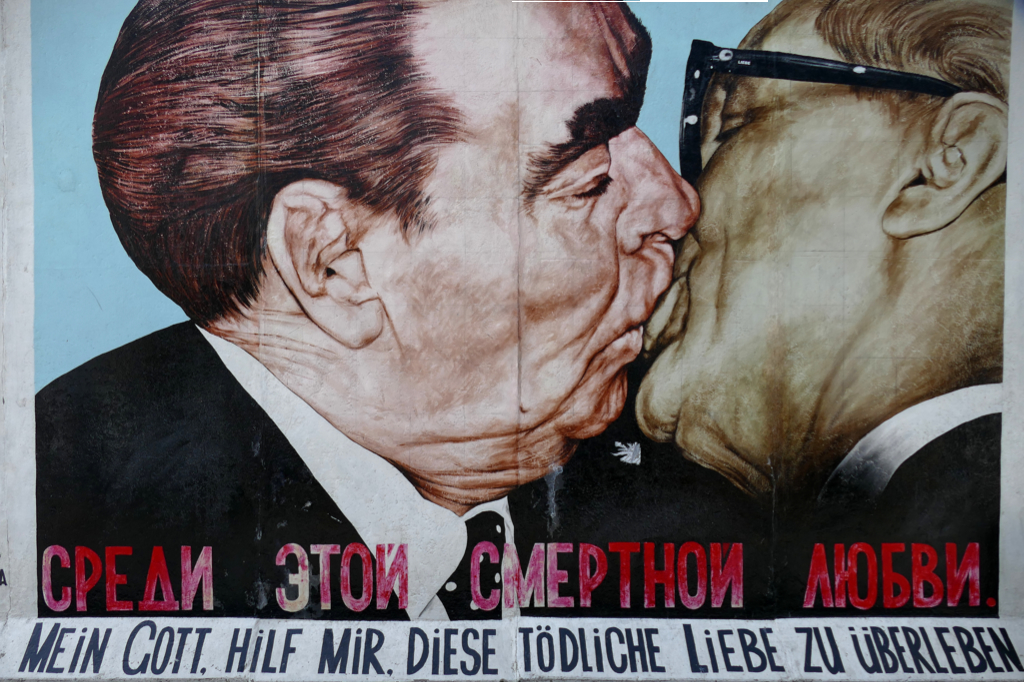
Fun fact: Eleven years after its first publication, the Bossu’s legendary kiss became a symbol of the artist’s private lovesickness. As he had to choose between two women at the time, Vrubel chose the capture My God, help me, this deadly love to survive for his artwork.
Sadly, only a few days after I published this post, Dimitri Vrubel passed away on August 14, 2022. Like any great artist, he will live on in his unforgettable work.
Birgit Kinder
Another iconic work is the Trabi by Birgit Kinder. Being born and raised in the former GDR, the artist painted her masterpiece on several segments of the former so-called anti-fascist protective wall. The government in the GDR used this euphemistic title for the wall.
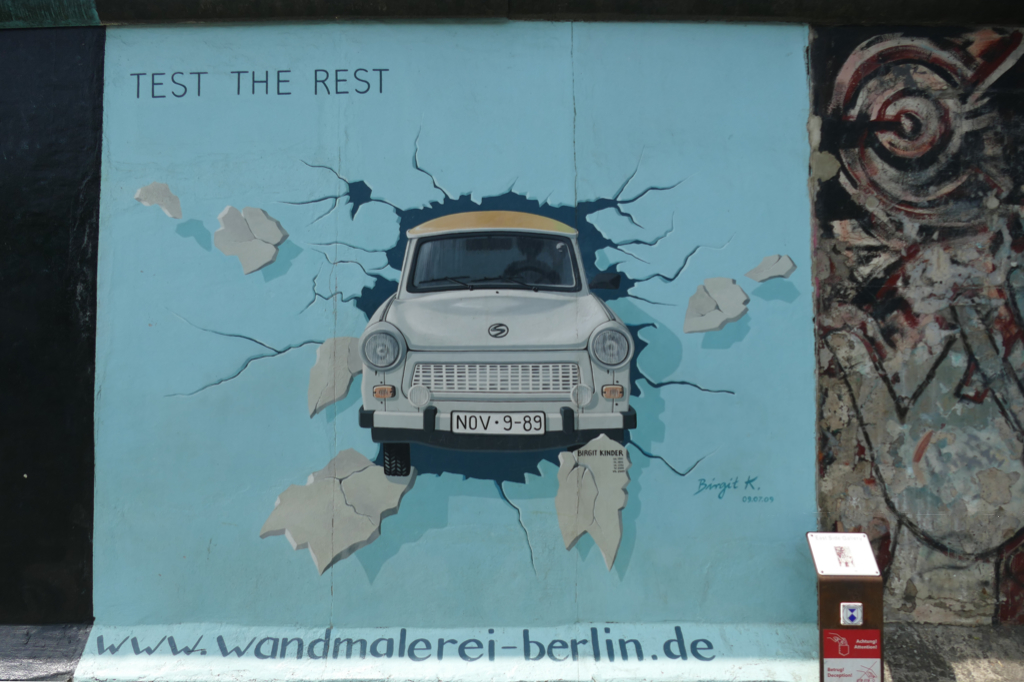
To the artist, the Trabi stands for the GDR’s lack of technical progress and environmental oblivion. As this car was completely constructed from plastic, it offered little driving comfort and safety.
In her painting, however, the frail little Trabi crashes through the military bulwark of the division of Berlin. However, the Trabi is not damaged in any way – not even the mirror is off. To the artist, this is the metaphor for a peaceful revolution that causes no damage or harm.
Schamil Gimajev
Another grand masterpiece is the work Worlds People – We Are One People by the Russian artist Schamil Gimayev.
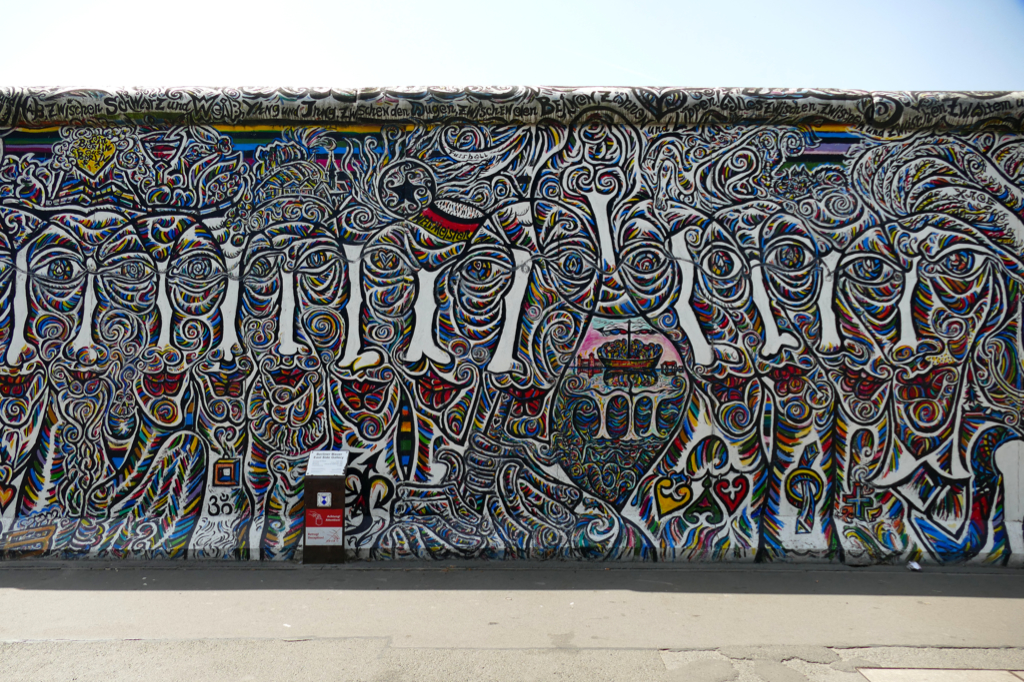
With a width of 44 meters, it is actually the longest painting in the East Side Gallery.
With fine black lines, Gimayew opens a window to the past and to opposites such as peace and war, men and women, black and white.
Jim Avignon
Avignon works as a painter, musician, and conceptual artist. He lives and works in Berlin and is known for often selling or even giving away his numerous, rapidly produced paintings at very low prices. Therefore, his art has already been referred to as cheap art.

Apart from other publicly accessible works around Berlin, Avignon contributed a remarkable mural to the East Side Gallery.
Fun fact: When the East Side Gallery in Berlin was extensively restored in 2009, the 115 artists were required to copy their old murals. Understandably, there were minor protests against these instructions, since the artists were not involved in the decision-making processes at all.
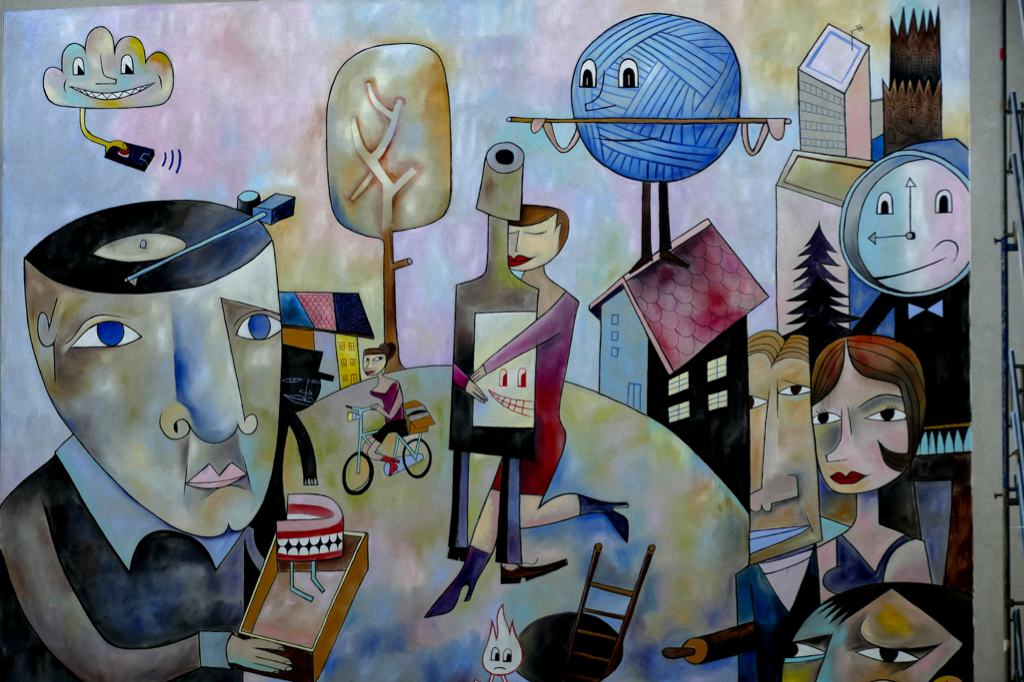
Jim Avignon, however, did not stick to the official rules and had redesigned his work on his own initiative. Ironically, the new motif addresses the changes in Berlin. The monument protection authority examined the imposition of a fine since his former painting was under monument protection
Igansi Blanch
Ignasi Blanch i Gisbert is a Spanish illustrator. After his graduation in Fine Arts from the University of Barcelona, he lived in Berlin for three years. Since he was a resident of Berlin when the wall came down, was chosen as the sole participant from Spain in the East Side Gallery.

Today, Blanch works as an illustrator and also teaches illustration at the Barcelona Provincial Council’s Escola de la Dona.
Hervé Morlay and Andreas Paulun
Too bad that apart from the artists’ names, I cannot give you any information on this very intriguing work showing some celebrities. They have in common that none of them had it easy.
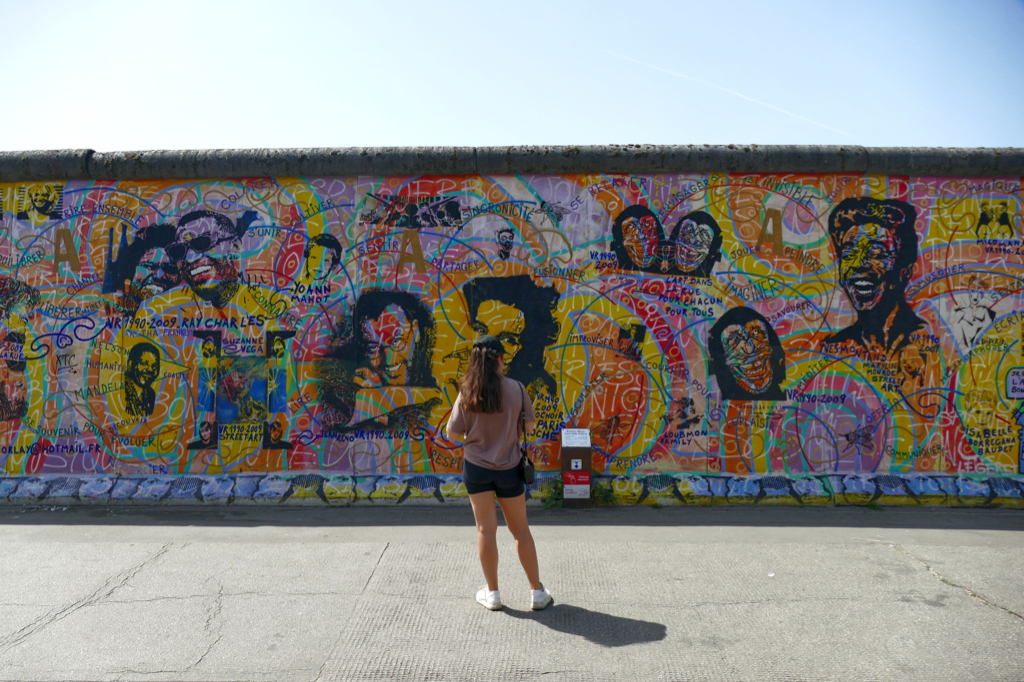
Klaus Niethardt
Klaus Niethardt called his mural Justitia – justice. I think you’ll understand the meaning behind this title when you consider that he was born in the Federal State of Thuringia and later lived in Leipzig in Saxony, hence, that he spent his life behind the wall in the former GDR.

Initially, he worked as a laborer. As a member of a drawing circle, he received high recognition for his artistic work and made a career as a decorative painter.
Today, Klaus Niethardt, who sadly passed away in 2005, is known mostly for his mural at the East Side Gallery.
I’ve added his work to this list since he’s depicting the German poets Schiller and Goethe as well as Nobel prize winner Albert Einstein. Next to all the sad and dark topics depicted on this wall, these three men are representing Germany as the proverbial land of poets and thinkers.
So yes, it was not easy picking only seven examples of what to expect on your stroll alongside the East Side Gallery. As I explained above, it’s almost 1.5 kilometers long which makes it impossible to introduce all the featured artists.
Nevertheless, you can learn more about the gallery on their website.
Alice Pasquini
As in all the arts, there are far more guys than gals embellishing the walls of the world’s metropoles. Hence, although Alice Pasquini’s portraits of hipster girls are not at the East Side Gallery, I’m introducing them here before we continue to Kreuzberg. You’ll find her mural Suspended around the corner at Warschauer Straße 47.
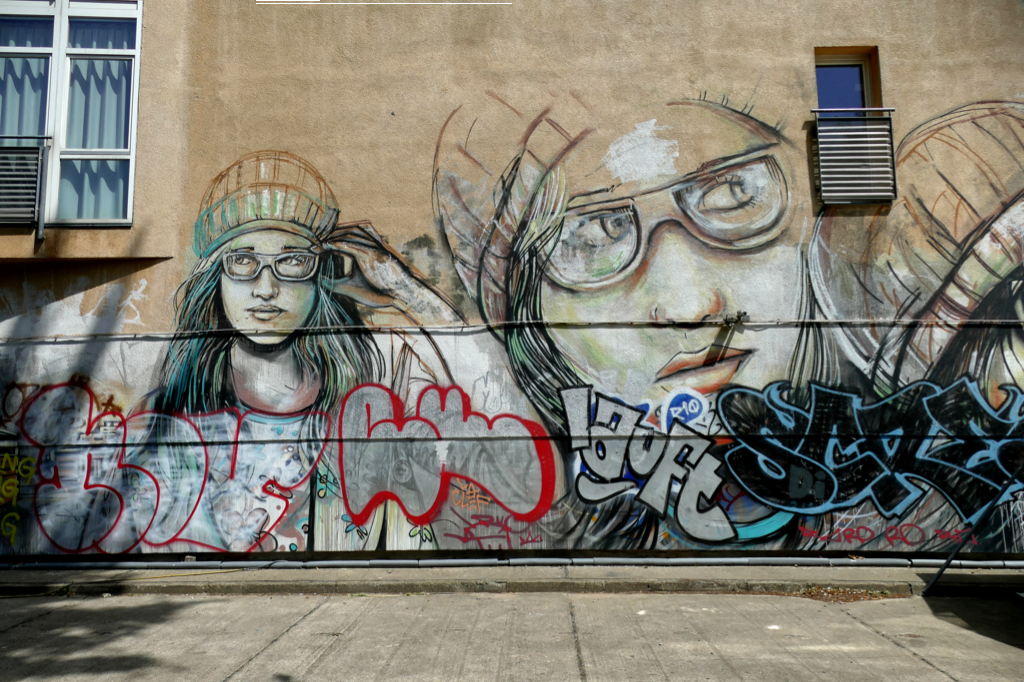
Alice Pasquini studied art and runs a small studio in San Lorenzo neighborhood of Rome. She is one of the far too few women internationally known for their urban art.
Apart from Berlin, her murals can also be seen in other European cities such as Rome and London. She also draws comic strips and works for advertising campaigns like for instance Nike and Range Rover.
Kreuzberg
At the time when Berlin was divided, Kreuzberg was in the western sector, however, surrounded on three sides by the wall. Hence, an alternative culture developed on the eastern edge of West Berlin. Kreuzberg has a lively nightlife and cultural life that is well known beyond the city limits. Renowned artists and institutions have their bases in the district.
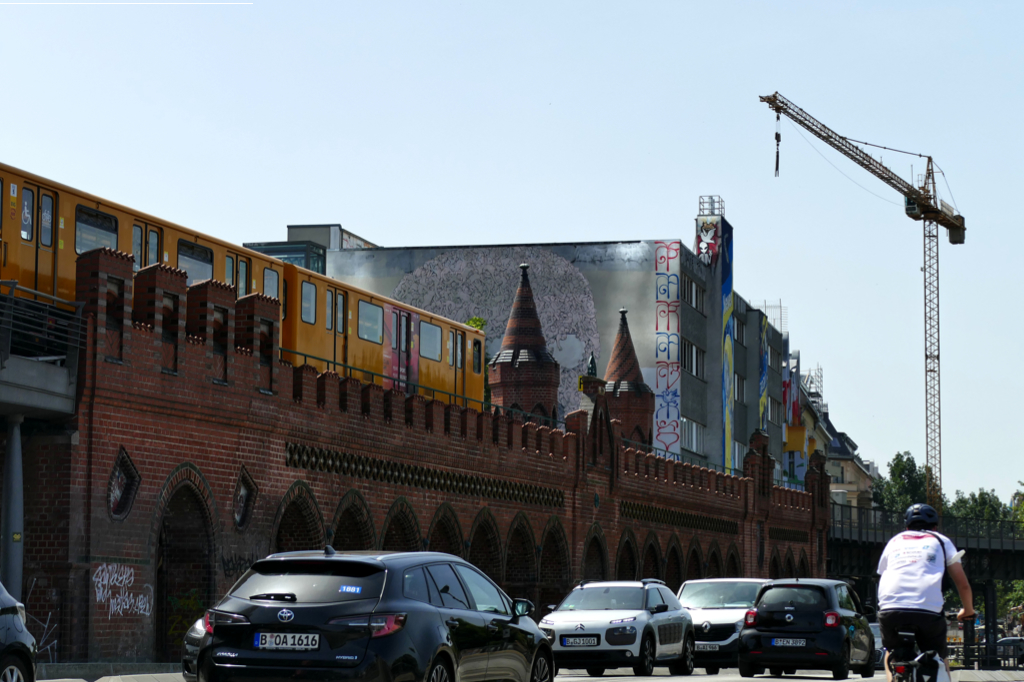
Kreuzberg is actually one of the most densely populated districts of Berlin. Since the Wilhelminian era, many edifices consisted of a representative front building, side wings, and up to four rear buildings. To this date, there are building complexes accommodating up to 150 parties in on house.
Nevertheless, Kreuzberg is also considered one of the lowest-income areas in Berlin. Almost a third of the approximately 160,000 inhabitants are migrants, many of Turkish origin, and their descendants. Back in the 1970s and 1980s, also Berlin’s alternative movement and the squatting scene were active mainly in this neighborhood.
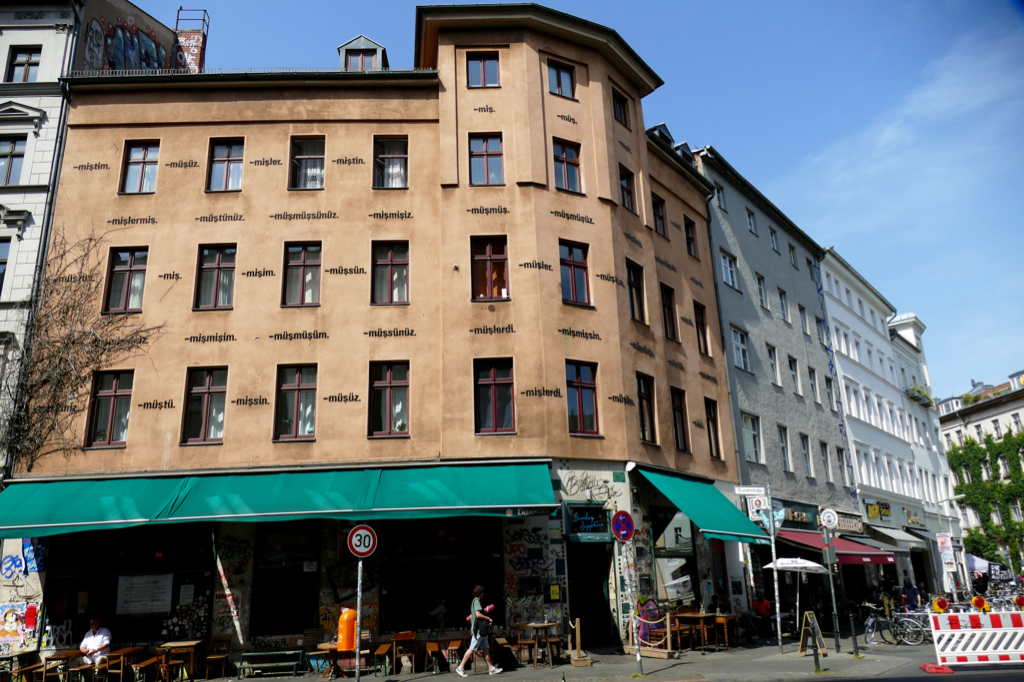
Nevertheless, since the beginning of the 21st century, the demographic structure of Kreuzberg has been changing due to gentrification effects. Today, the neighborhood is one of Berlin’s trendy’n’touristy districts.
Ayşe Erkmen
To me, Urban Art is not exclusively graffiti. Sculptures are Urban Art, too, as well as architecture. Therefore, I begin my chapter on Urban Art in Kreuzberg with a façade designed by Ayşe Erkmen who is by far not a classic street artist.
In 1994, the Turkish-born artist got the opportunity to design the façade of a newly renovated residential building in Oranienstraße 18. Initially, it was her contribution to the exhibition İskele that introduced young Turkish artists in Berlin. However, what was only supposed to be temporary work, was met with so much enthusiasm by the bypassers and inhabitants alike that the Turkish word endings are hovering over the square to this date.
Ayşe Erkmen been teaching at the Academy of Arts in Berlin since 2012. Yet, she’s still active as an artist and has participated in more than 60 exhibitions worldwide. In 2011, she represented Turkey at the 54th Biennale in Venice.
BLU
Blu was born in Senigallia in the Marche region on Italy’s east coast in the early 1980s. Today, he’s living in Bologna.
Since he’s carefully hiding behind his pseudonym, it’s basically impossible to find out more about him as a person. Experts describe this graffiti, street art, and video artist as one of the internationally most noteworthy and essential street artists of muralism.

Since the mid-1990s, Blu’s works decorate walls in several European countries, in the Americas, as well as in the West Bank. In 2006, Lorenzo Fonda shot the documentary MEGUNICA about Blu’s work and travel through Mexico, Guatemala, Nicaragua, Costa Rica, and Argentina.
The Guardian voted his collaboration with Os Gêmeos, the famous street art twins from São Paulo in southern Brazil, as one of the top ten street artworks in 2010.
I’ve introduced his famous mural Moses With the Beard in my post on Best Street Art in Valencia.
On the wall behind the Oberbaumbrücke, he depicted some kind of a pink oger composed of tiny humans.
Art For Ukraine
Around the corner from BLU’s pink oger are two large panels. On the left one is a girl following a group of people from east to west. Looking back over her shoulder, she’s carrying only her most precious things like her cat and the goldfish in a plastic bag.

The right panel shows in a rather abstract style the horrors of the war like a bomb hitting a house, a hand pushing a Russian warship back east. Below the Kremlin is drowning in blue blood.
These panels were created by Valeryia from Belarus and Somari, Olga, and Anna from Ukraine. All four ladies are now based in Berlin – some of them came here only very recently as they had to escape the horrible war in their home.
ROA
I’ve introduced ROA for the first time in my post on Urban Art in Málaga.
ROA is an enigmatic muralist from Ghent. His love for music, particularly hip-hop, pulled him towards graffiti. Like many muralists, he began by illegally spraying bridges and walls.
Today, ROA is mainly known for rodents, but also birds and other animals. He paints them including the skeleton and intestines which makes them look even more realistic. While he first painted buildings and walls in his hometown, you’ll find his distinctive pieces in black and white not only throughout Europe, but worldwide.

In Berlin, he has left his mark on various walls. One of his most famous works is located directly on the Görlitzer Park, Kreuzberg’s recreation area. The morbid mural is, as always, in black and white and deals with the topics of death and decay as it depicts a dead rabbit, a stork, and a roebuck.
ROA insists to remain anonymous in order to keep his work independent and his spirit unburdened.
Axel Void
Alexjandro Hugo Dorda Mevs was born in Miami to a Haitian mother and a Spanish father in Miami. However, when he was 3 years old, the family moved to Spain where he later studied fine arts. Today, he lives and works again in Miami.
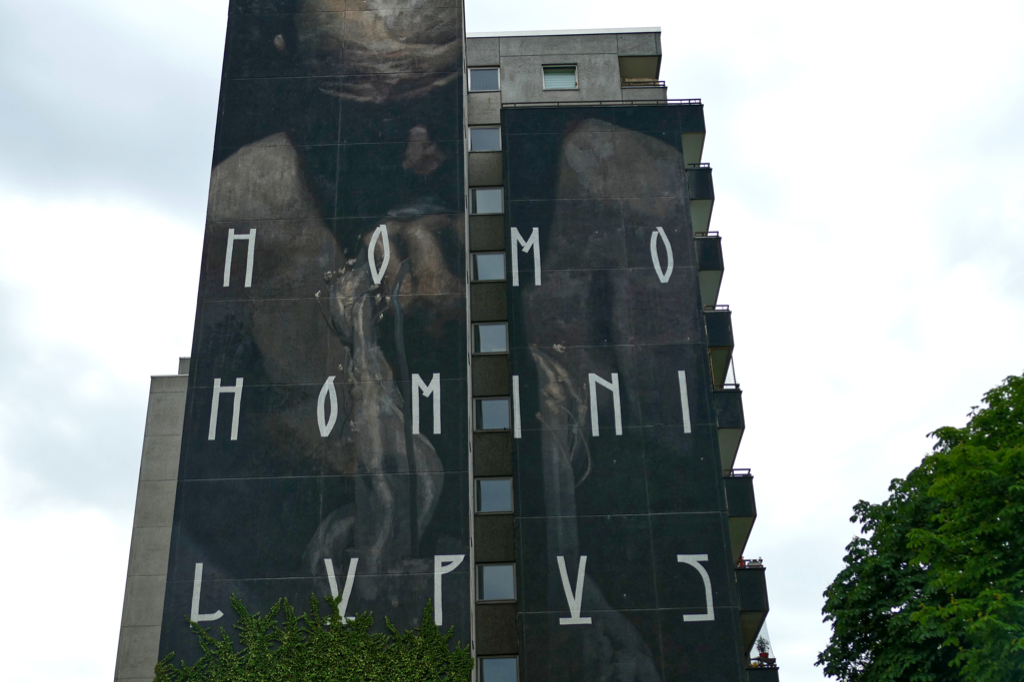
Axel Void processes his multicultural roots and upbringing in his dark work – dark in color as well as regarding the message.
Francisco Bosoletti
Francisco Bosoletti was born in 1988 in Armstrong, Argentina, where he graduated from the Rosario Art School in 2010. He then began his career at an advertising agency.
On a trip to Europe, starting in London, he began to sketch. As people noticed and appreciated his talent, the young artist realized that he might make a living from his art.
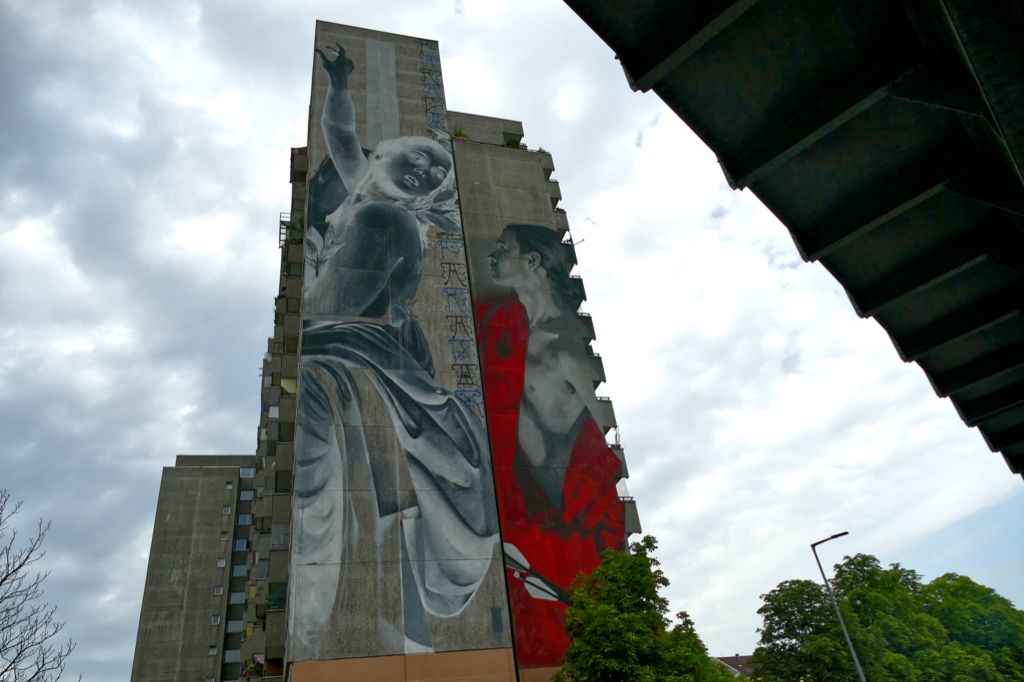
In 2018, he painted in a negative light a portrait of Daphne from the Greek mythology Apollo and Daphne. Young Jarus, whom I’m introducing below, pained Apollo.
Their twin portrait is definitely one of Berlin’s most outstanding murals.
Young Jarus
Young Jarus was born in Saskatchewan in 1992 and has a degree from the Academy of Realist Art Toronto. He uses various mediums such as acrylic and spray paint for his hyper-realist portraits. His work is found in numerous cities in Canada, the US, Mexico, and Europe, obviously.
Beginning of 2018, he portraied Apollo from the Greek mythology Apollo and Daphne.
Emily Eldridge
US-born Emily Eldridge used to live in Hong Kong, in Barcelona, and is now based in Berlin. Her artistic actifities range illustration to street art as well as from graphic design to installations. In short, she’s creative.
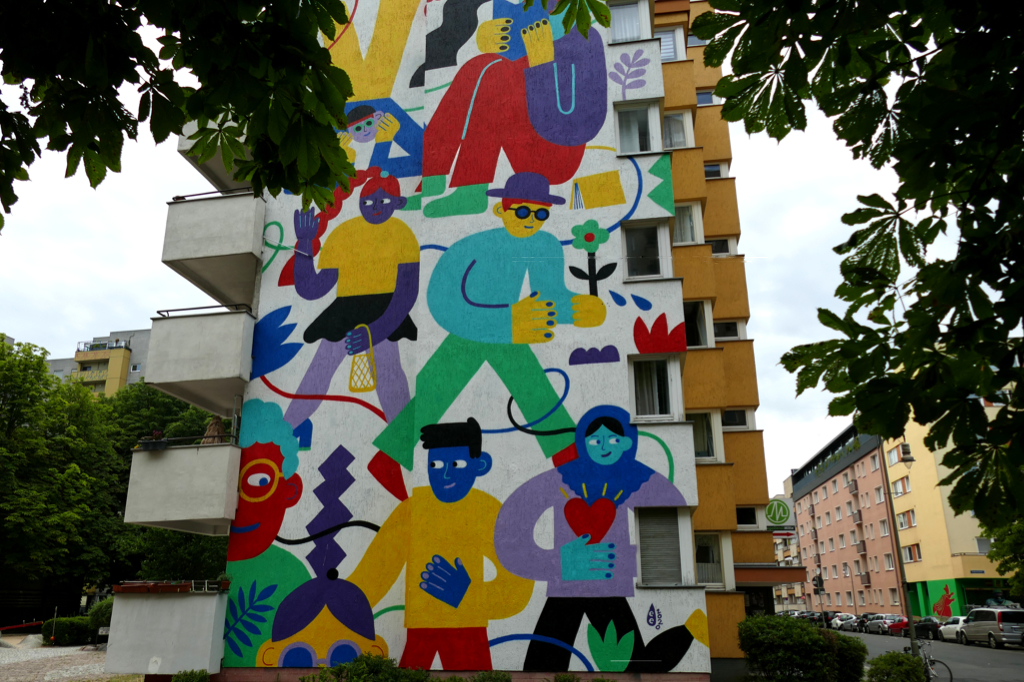
Emily Eldridge graduated with a Bachelor of Fine Arts in Illustration from the Savannah College of Art & Desig in Georgia in 2004. Then she added two Master’s Degrees during her stay in Barcelona.
She has painted murals in Hong Kong and China, in the US, and in Europe, obviously. She’s working for big companies such as Adidas and Uniqlo, to name just two.
Katrina Voronina
In cooperation with the global street art community, Amnesty International initiated the urban art project Brave Walls. Obviously, it is dedicated to human rights defenders. The first Brave Wall was created in London in 2017. Today, there are Brave Walls in more than 20 countries. In 2021, Berlin’s first Brave Wall was introduced to the public.
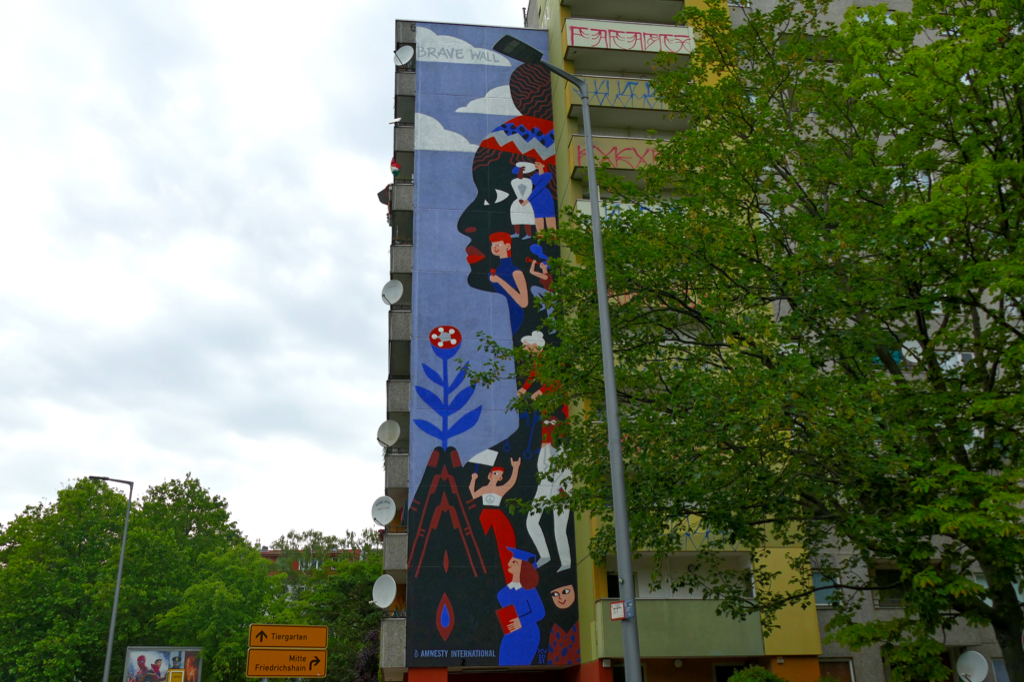
A jury had chosen Moscow-born and Berlin-based artist Katerina Voronina to decorate a wall with the story of human rights activist Marielle Franco. Franco was murdered in her hometown of Rio de Janeiro in 2018.
Herakut
Herakut is the artist duo consisting of the two German artists Jasmin Siddiqui and Falk Lehmann. In 2014, they merged their aliases Hera and Akut into Herakut.

Their art is based on social and humanitarian ideas’n’ideals. Therefore, about half of their creations is committed to charity causes such as shelters for abused children and refugee camps, to name just two.
Millo
Francesco Camillo Giogino was born in Italy in 1979. Today, he goes by the alias Millo. Having studied architecture, he is now decorating façades with murals of mostly monochromatic black and white lines.

His motifs and compositions are often like illustrations from children’s books – innocent, playful, and clear. I believe this can be a hidden message, too.
Millo’s murals are decorating façades in Florence, Rome, Milan, and Bologna, but also in Paris, London, and even Rio de Janeiro.
Various & Gould
In 2010, Various & Gould graduated from the art school Kunsthochschule Berlin-Weißensee. However, the Berlin-based artists have been working together since 2005.
They are mostly working with paper, creating collages, screen prints, and posters.
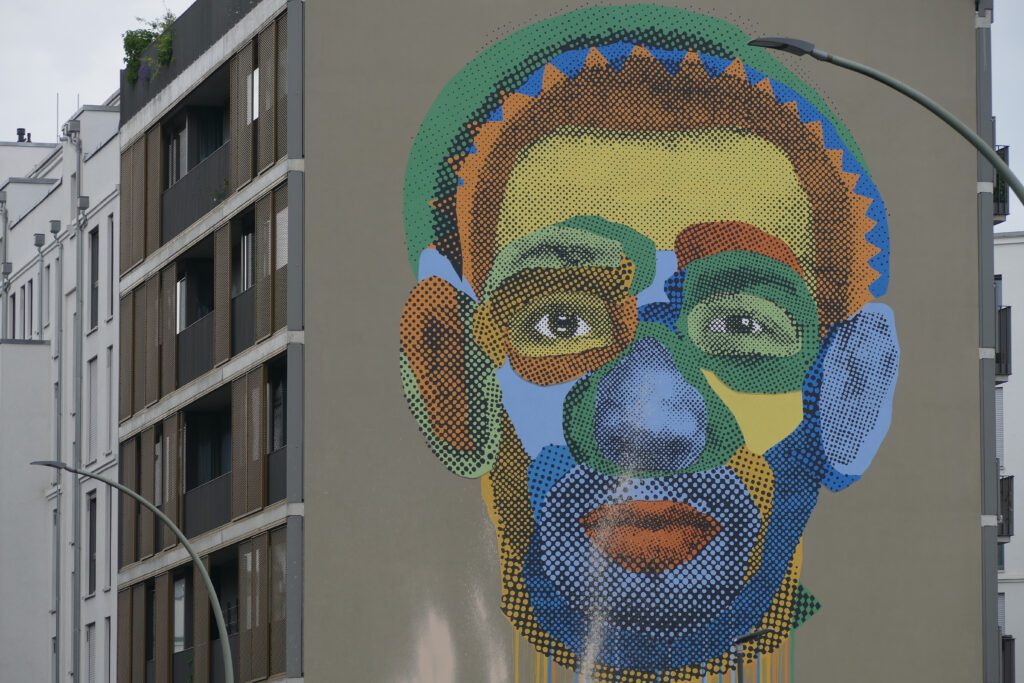
Various & Gould tackle socially relevant topics such as gender, migration, and globalization in a subtle way, but at the same time in bold colors and ambiguous insignia.
in their series Face Time, no real people are portrayed. The collages are composed of parts of different faces and expressions.
Case Maclaim
Case Maclaim, also known as Andreas von Chrzanowski, is one of the founding members of the renowned Ma’Claim Crew where also Jasmin Siddiqui and Falk Lehmann from Herakut are rooted. In his hyper-realist paintings, the sights’n’signs of hands play a major role.
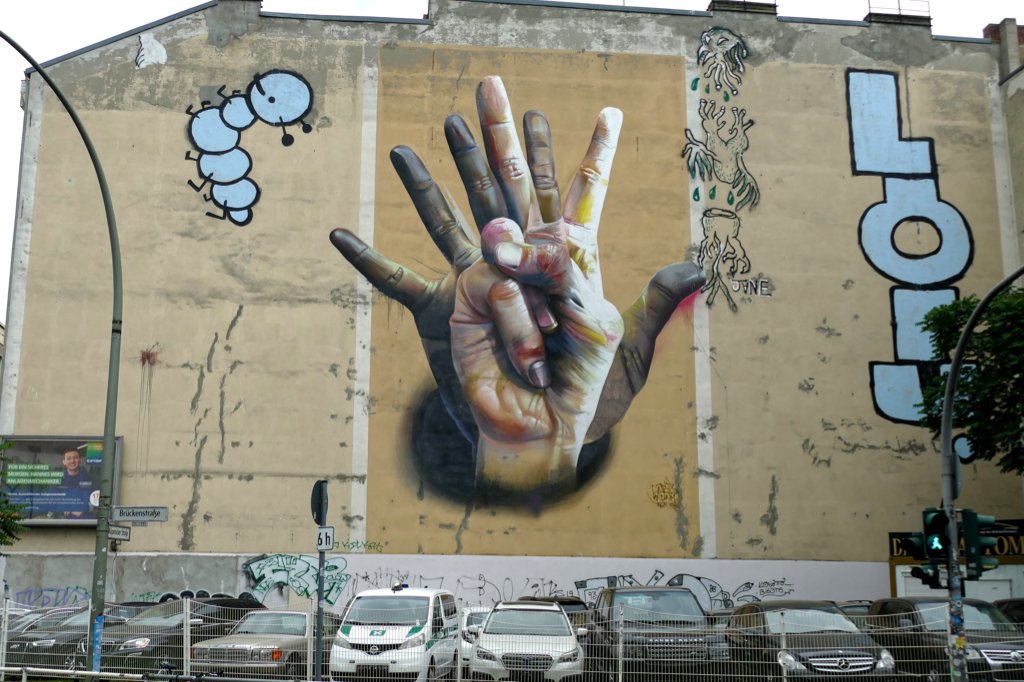
Ever since he started to paint in 1995, he has left his fingerprints – metaphorically and also literally – in over 20 countries. No wonder, the sign language of his hand is globally understood.
Shepard Fairey
Who doesn’t know Mr. Frank Shepard Fairey? Whereby, his pseudonym OBEY might sound more familiar to you. Born in 1970 in Charleston, South Carolina, this street artist, graphic designer, and illustrator has been around quite a while.
His first claim to fame was his André the Giant Has a Posse sticker campaign. In 1997, he co-founded the design agency BLK/MRKT, specializing in guerrilla marketing campaigns. Customers were none less than Pepsi, Hasbro, and Netscape. In 2003, Fairey left BLK/MRKT and established his own agency called Studio Number One. Also, this whizz-kid launched the fashion label OBEY clothing in 2001.
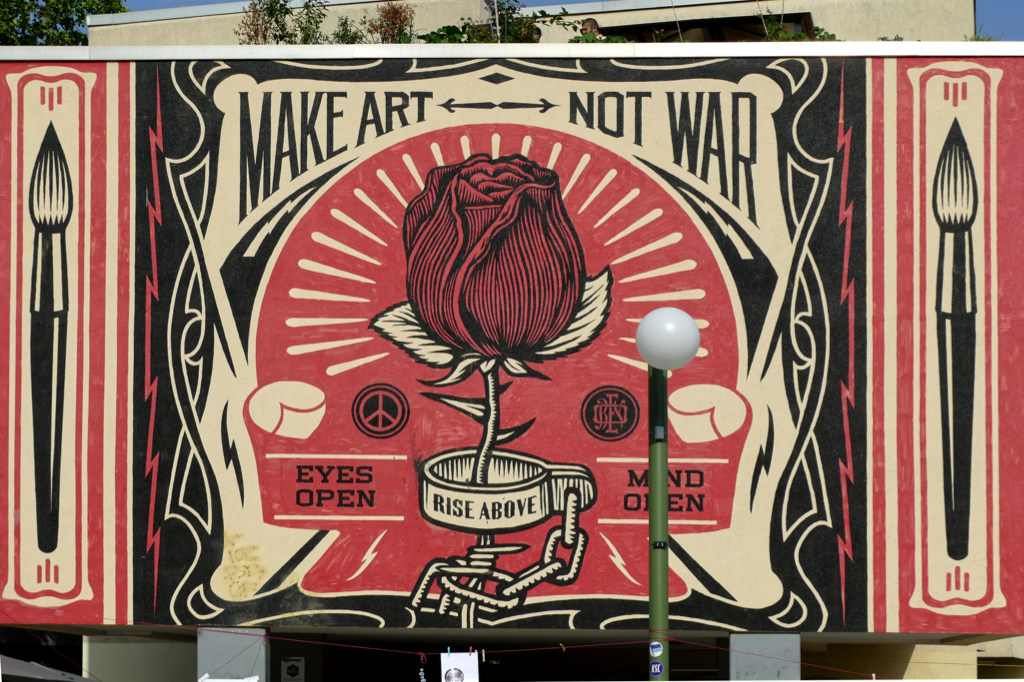
Fairey had a major appearance in the legendary street art documentary Exit Through the Gift Shop by British artist Banksy 2010.
Sidenote: Fairey achieved greater notoriety during the 2008 US presidential election campaign with his iconic poster HOPE for Barack Obama. It is actually only the most famous of a series of posters that he designed for the Obama campaign. Eventually, he endorsed Democratic candidate Bernie Sanders in the 2016 United States presidential primary.
If you like Shepard Fairey, make sure to check out my post on Best Street Art in Málaga where he participated in the art project MAUS.
Don John
Don John from Copenhagen is known for his transformation of people, animals, and nature. He’s morphing animals and humans into surreal coexistence or even symbiosis. This way, Don John is not only inspiring the viewer, but he’s also embellishing his environment.
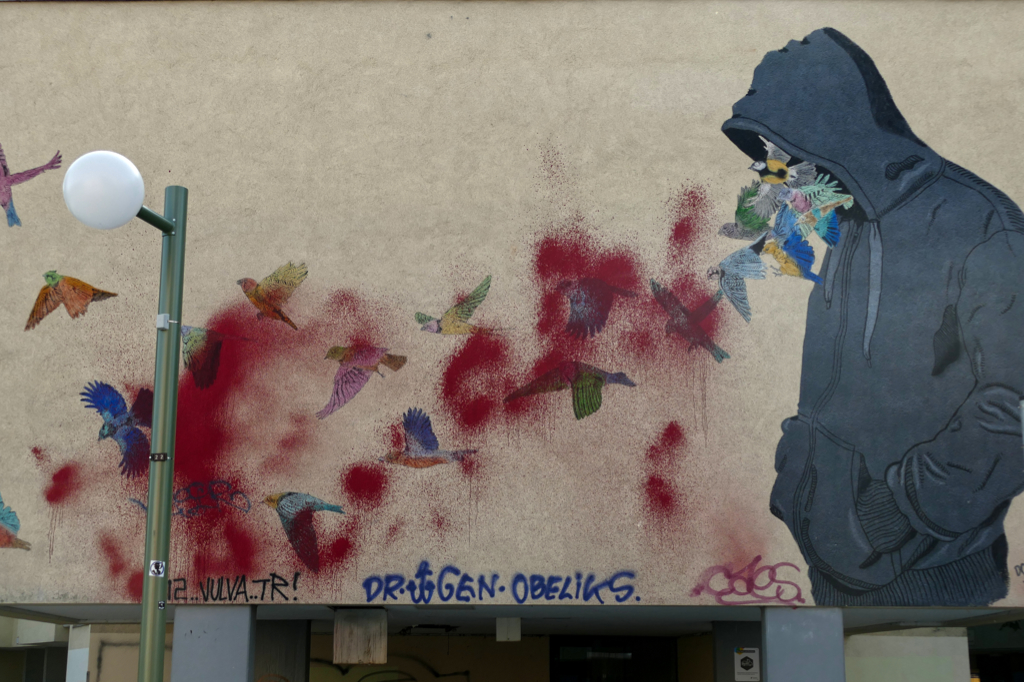
To this date, he did so in cities like George Town in Malaysia, New York, and Reykjavik.
PichiAvo
It wasn’t by incident that my post on Street Art in Valencia was one of my first articles on Urban Art ever. After all, it’s one of the most vibrant places in Europe when it comes to Street Art. No wonder that many internationally recognized Urban Artists are coming from this city in southern Spain. For instance PichiAvo, a duo consisting of Pichi and – you probably guessed so – Avo.
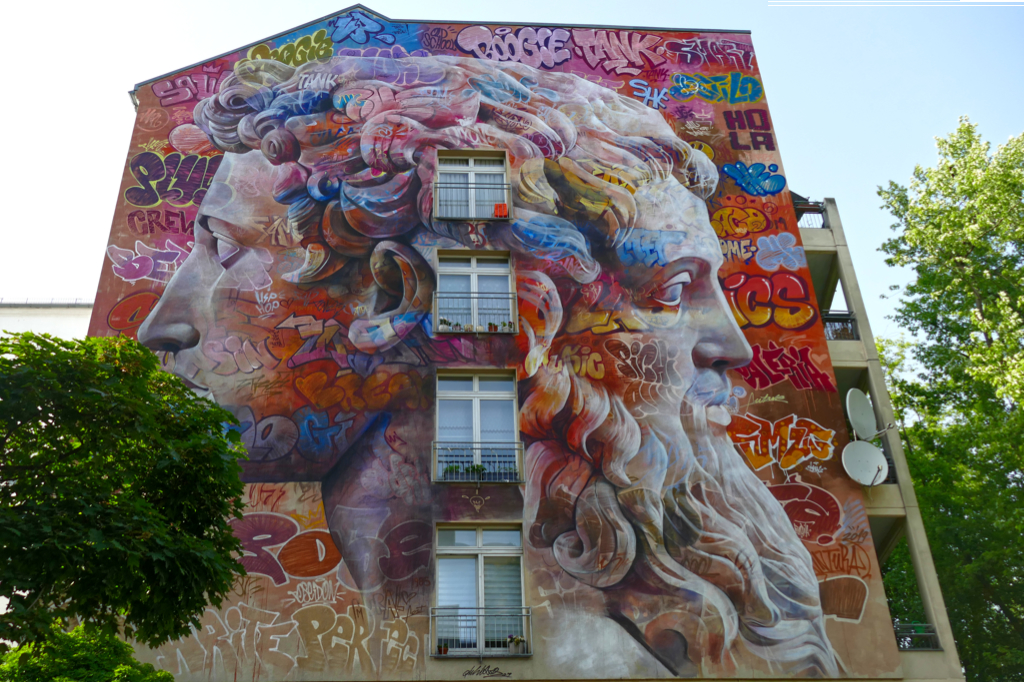
Since 2007, PichiAvo have successfully worked also internationally. As a matter of fact, they were the first European street artists who contributed to the legendary Houston Bowery Wall in New York in 2017. In 2019, they created together with VHILS the world’s second-largest mural in the city of Porto.
It’s a good thing that they are trained in Fine Art since this way, they combine classical motifs with techniques of street art.
ARYZ
Another well-known Spanish street artist is Aryz. Although he was born in 1988 in Palo Alto in California, he came back to Spain as a small kid and grew up in Barcelona.

Around the globe, Aryz is a highly recognized artist. He has painted in various countries in and outside of Europe including China, Finland, France, Italy, Japan, Morocco, the US, and Venezuela. In 2012, he collaborated with Brazilian street art superstars Os Gemeos on a mural in the Polish city of Lodz. In 2013, he embellished homes and boats in the small village of Andavadoaka in Madagascar with his art.
I introduced another one of Aryz’s impressive murals in my posts Best Street Art in BRISTOL – Part I: From Nelson Street to Stokes Croft.
Jadore Tong
Jadore Tong was born in 1970 in Weimar and grew then up in Paris and Berlin. Since he’s working on walls as well as on canvas, he connects painting with street art techniques. He also realizes art projects under the pseudonym Syrus – which stands for Save Your Rich Untouchable Soul.

Shortly after its creation, his Elephant Playing With A Balloon became one of the most popular murals in Berlin.
Schöneberg
Urban Art in Berlin is mostly associated with the East Side Gallery. That’s understandable since you get to see a large variety of inspiring murals in one spot. Nevertheless, there are grand murals basically all over Berlin – grand in size and artistic value. However, don’t let those larger-than-life pieces distract you from the small gems in between. Those small stickers can be well-designed and bear a bold message.
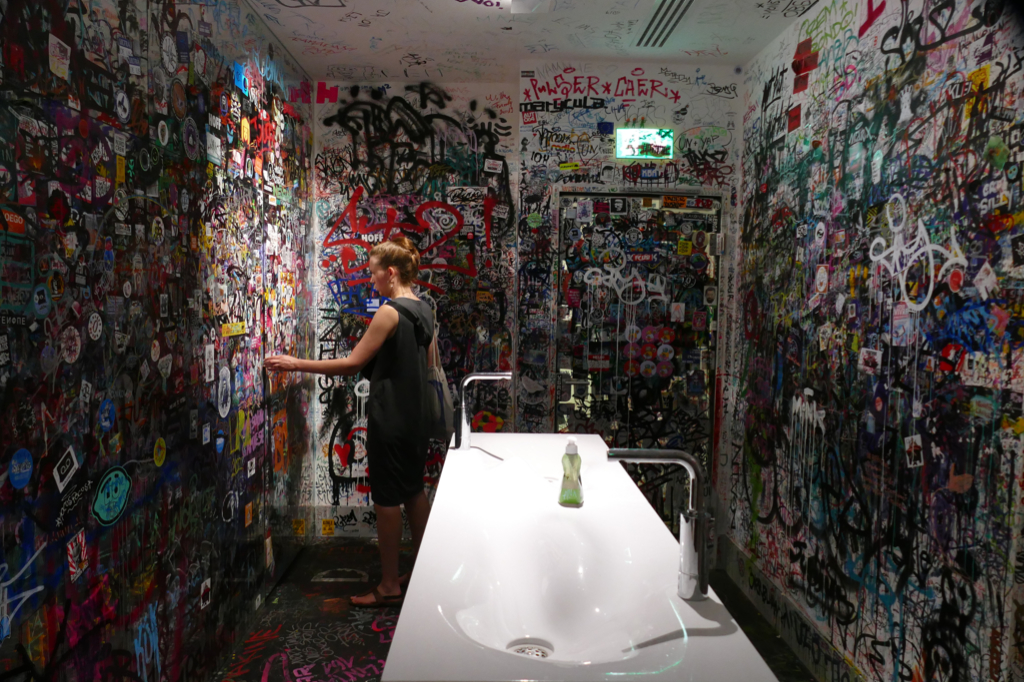
Since Urban Art is spread across the entire city, I’ve limited myself to three agglomeration spots. I might add a second post on Street Art in Berlin, but for now, I’m introducing Friedrichshain, Kreuzberg, and in this third part Schöneberg.

Bülowstrasse and the sidestreets are great places to spot Street Art. Whether big or small, whether by famous artists or not-yet-known sprayers’n’painters, you won’t be disappointed.
Also, since 2017, Street Art has a home in Schöneberg. The art museum Urban Nation for Urban Contemporary Art is housed in a Wilhelminian-style building that was remodeled for this purpose.
Just like in the streets, you’ll get to see works by world-famous artists as well as newcomers. As a matter of fact, I don’t enjoy seeing Urban Art in captivity. Will say, I want to discover it in more or less unexpected places. But what I like a lot is the museum’s façade. It is covered by huge mobile panels that are being changed. This way, the museum surprises visitors with different works inside as well as on the outside.
D*Face
Dean Stockton, far better known by his pseudonym D*Face, is a British multimedia street artist. He works with spray paint, stickers, posters, and stencils. Among the artists listed in this post, he’s indisputably one of the alpha superstars.
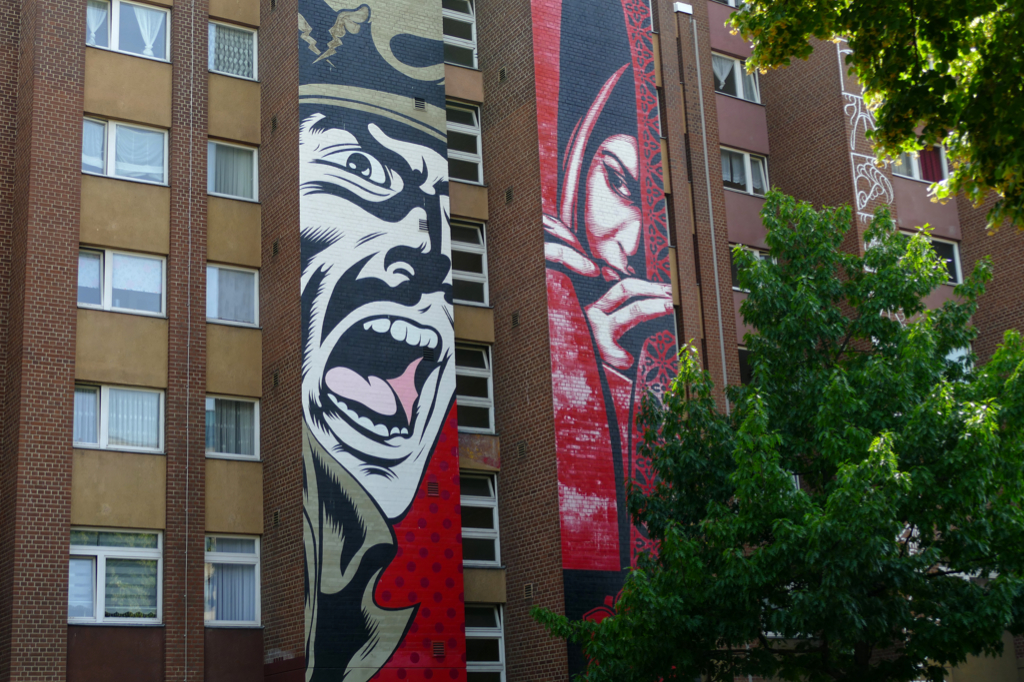
D*Face grew up in London and had an interest in graffiti and related cultural phenomenons such as hip hop, punk, cartoons, and skating. Later, he attended illustration and design classes and worked as a freelance designer whilst perfecting his street work.
D*Face was the owner and curator for the Outside Institute, London’s first art gallery with a focus on street art. He designed covers for stars such as Christina Aguilera and the band Blink-182.
If you like D*Face, make sure to check out my post on Best Street Art in Málaga where he participated in the art project MAUS.
James Bullough
James Bullough grew up in Washington DC and is now based in Berlin. He taught himself realistic oil painting techniques by studying the Dutch Old Masters. Today, he combines their artistic accuracy with the swiftness of spray paint.
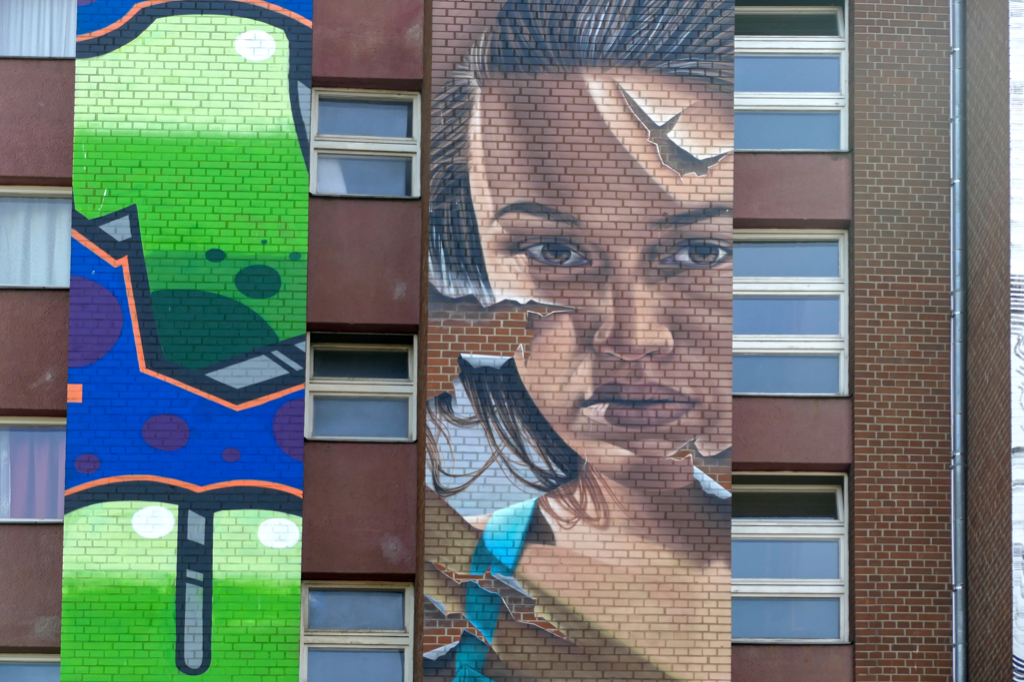
You find Bullough’s murals on many walls and his canvases in numerous galleries mainly in the US and in Europe.
Christian Böhmer
Christian Böhmer is an urban artist from Cologne. As a teenager, he taught himself how to write graffiti. Working as a professional interior designer by day, he creates street art after hours.
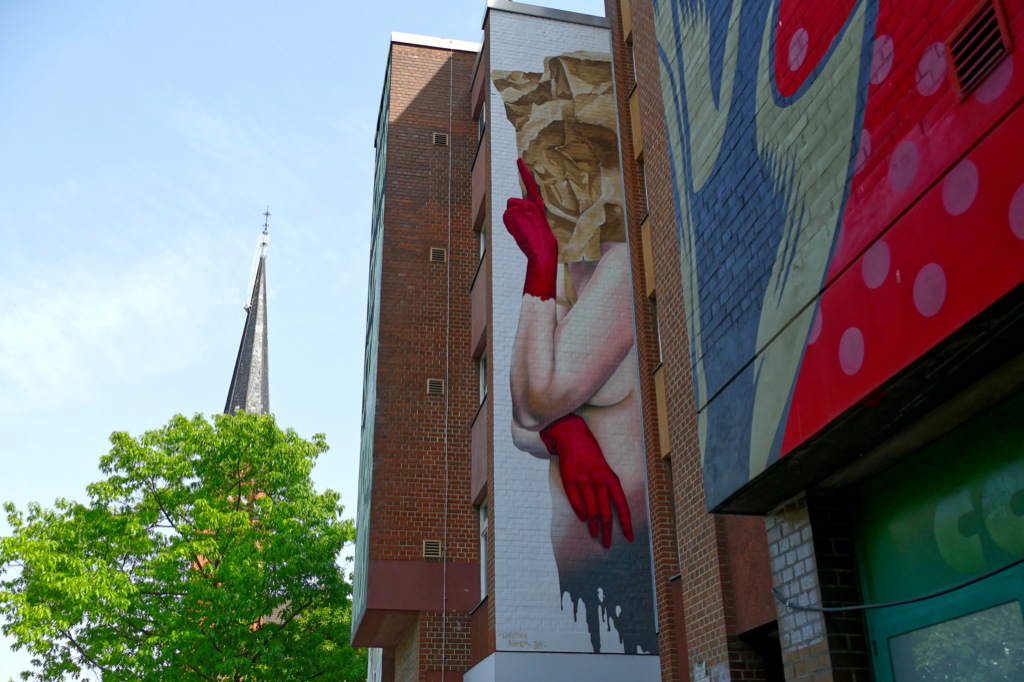
Today, he is famous for his detailed and hyper-realistic so-called ‘Paper Bag Heads’. Those are created by paste-ups, paint, or spraypaint.
Nils Westergard
Nils Westergard is a Belgian-American street artist and filmmaker. Just like James Bullough, he got in touch with stencils and graffiti as a teenager in Washington DC.
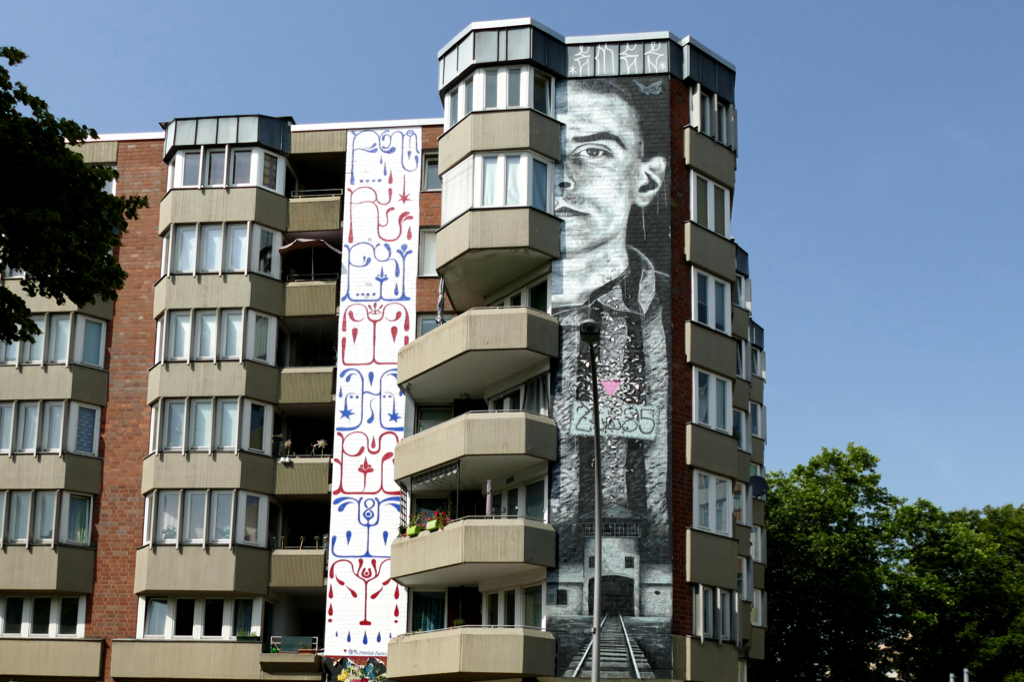
Today, he lives in Richmond, Virginia, and Amsterdam and decorates walls across the US, Europe, and Australia.
FIN DAC
Fin DAC was born as Finbarr Notte who has spent most of his life in London.
As he stencils women in ethnic clothes, his work is all about beauty and aesthetics. These portraits in predominantly black and white are strongly influenced by Asian art. Although he claims his art to be apolitical, he tackles racial and sexual stereotypes of women.
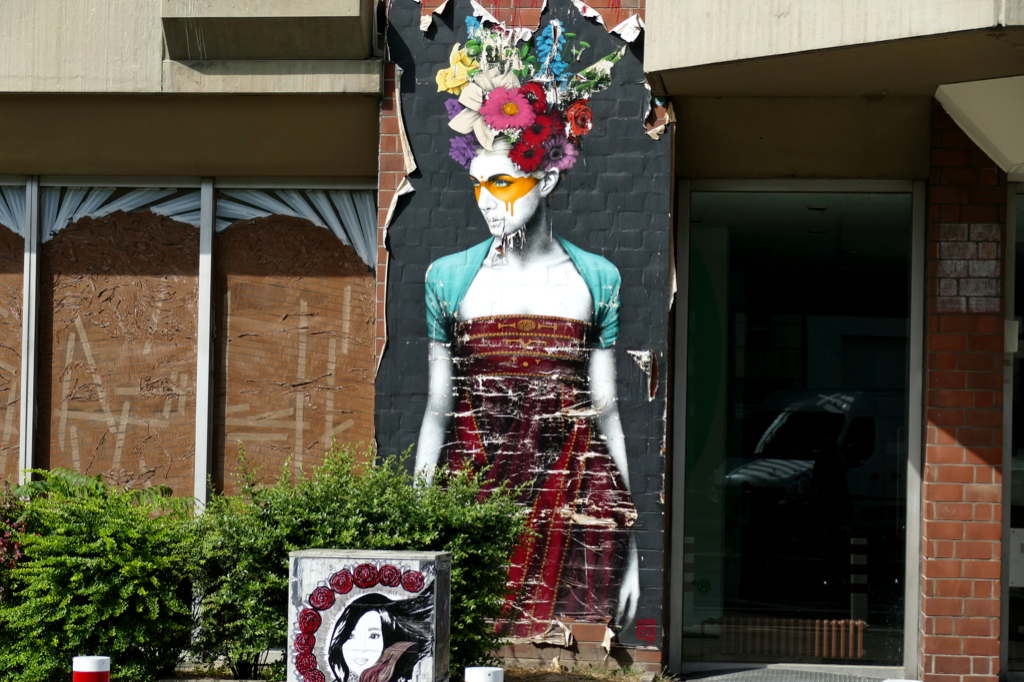
Fin DAC has created murals in Australia, Belgium, Cambodia, Canada, France, Mexico, Spain, Tahiti, and the US, to name just a few.
Hyuro
Hyuro is the pseudonym of artist Tamara Djurovic from Argentina. Initially, she worked on canvas. After she met the Spanish street artist Escif in Valencia, she began to paint murals. By the way, I’ve introduced Escif in my post on Street Art in Valencia.
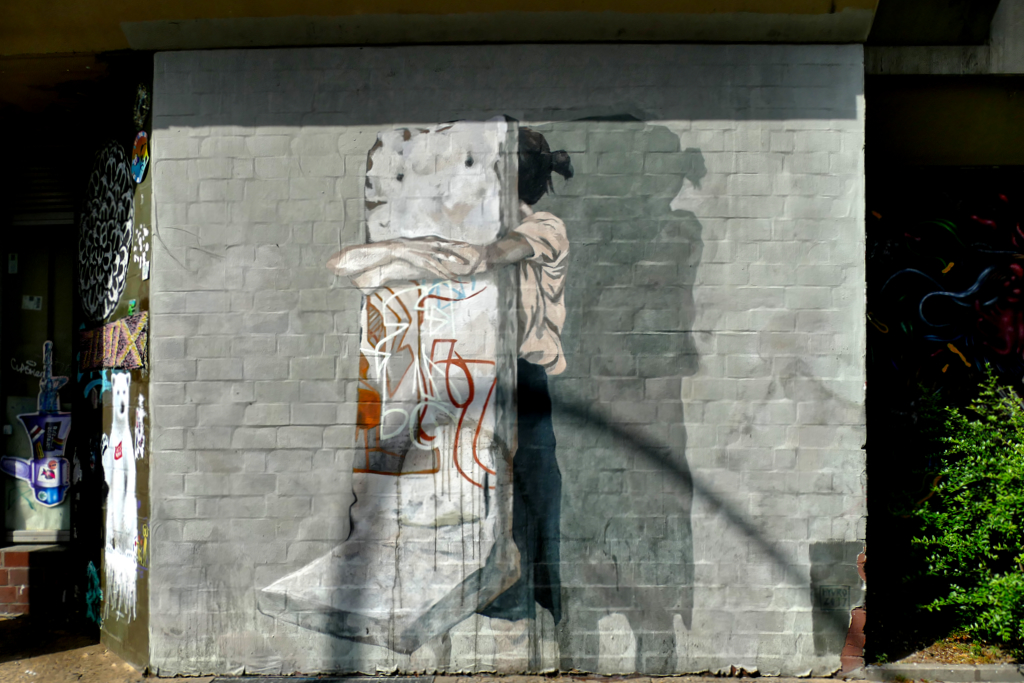
Fun fact: In 2014, Hyuro depicted a naked woman for the Living Walls project in Atlanta. After residents considered it to be pornographic, it was first vandalized and eventually painted over. Those people would probably also demand that Michelangelo’s David puts some clothes on.
Sadly, Hyuro died of leukemia in 2020. Nevertheless, her painted legacy around Europe but also in Argentina, Brazil, Mexico, Morocco, and Tunisia will live on.
On Instagram
Unfortunately, I cannot introduce all the great artists that have embellished Berlin’s façades. And even those few I’m presenting above have created many more amazing pieces.
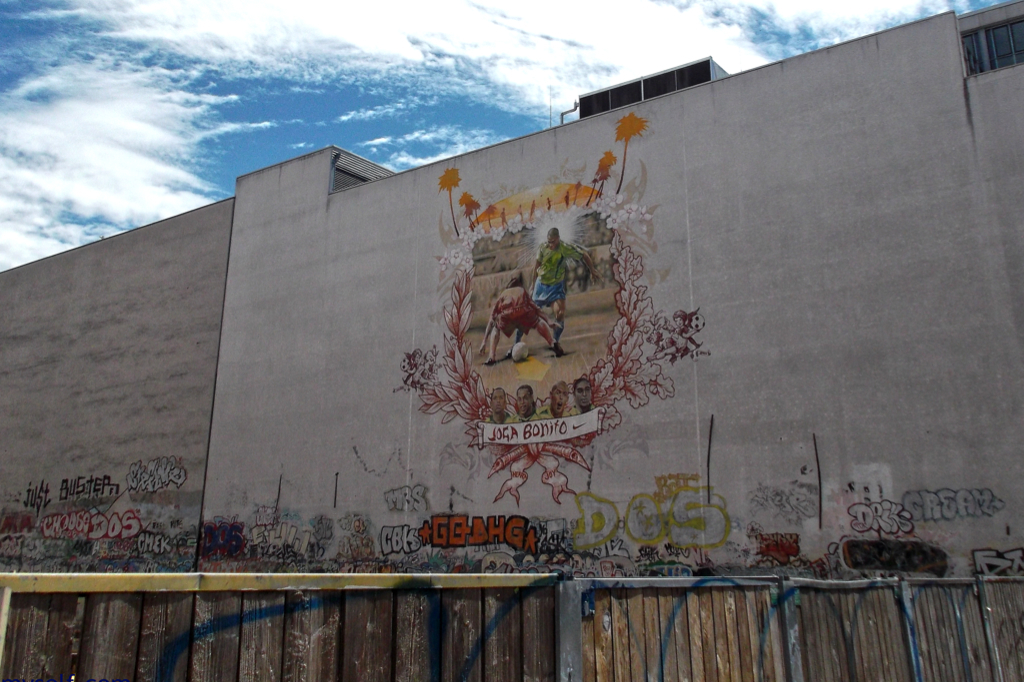
So if you want to dig deeper into the subject – or get inspired for your upcoming trip to Berlin – check out these accounts of the above-featured artists. Unfortunately, some of them – like Birgit Kinder and Schamil Gimajew – don’t have accounts. Nevertheless, you’ll find their works using the hashtags #birgitkinder, #schamilgimajew and #hervemorlay.
ARYZ
Jim Avignon
Ignasi Blanch
BLU
Christian Böhmer
Francisco Bosoletti
James Bullough
Cranio
D*Face
Don John
Emily Eldridge
Ayşe Erkmen
Shepard Fairey
FIN DAC
Hijack
Hyuro aka Tamara Djurovic
KlebeBande
Valeryia Losikava
Case Maclaim
Millo
Alice Pasquini
Somari Ptichka
ROA
Olga Sabadin
Anna Stativa
Jadore Tong
Various & Gould
VHILS
Axel Void
Katerina Voronina
Dmitry Vrubel
WENU artist collectiv
Young Jarus
Nils Westergard
How to Get Around
Berlin is Germany’s largest city, hence, don’t even think about exploring the city exclusively by walking. Even though I organized the street art in clusters according to neighborhoods, those individual areas are huge.
Obviously, Berlin has a comprehensive network of public transportation. There are subways, regional trains, trams, and buses. You can easily check the most convenient route on Google maps.
A single ride costs 3 €uros and only 2 €uros for a so-called Kurzstrecke. This short trip includes only up to 3 stops for S-Bahn or U-Bahn including interconnections. On buses and trams, a Kurzstecke consists of up to 6 stops. Hence, you can save a lot of money by getting a day pass for 8.80 €uros. Note that this pass is valid for 24 hours after clocking in. If you are travelling with others, a group ticket for €uro 25,50 for up to five people might be a more attractive option.
If you want to see more of Berlin than just Urban Art, the WelcomeCard is probably the best choice. You’ll get free access or at least reasonable discounts on tours and entries, but also on food and drinks at selected restaurants and shops. It also includes unlimited rides on all public transport. So this card grants you a far more complete and diverse program.
Cycling
While driving in the city center is rather a drag than a convenience, Berlin can easily be explored cycling. If your hotel doesn’t have bikes for rent, you can get them for instance at nextbike. You find their website here.
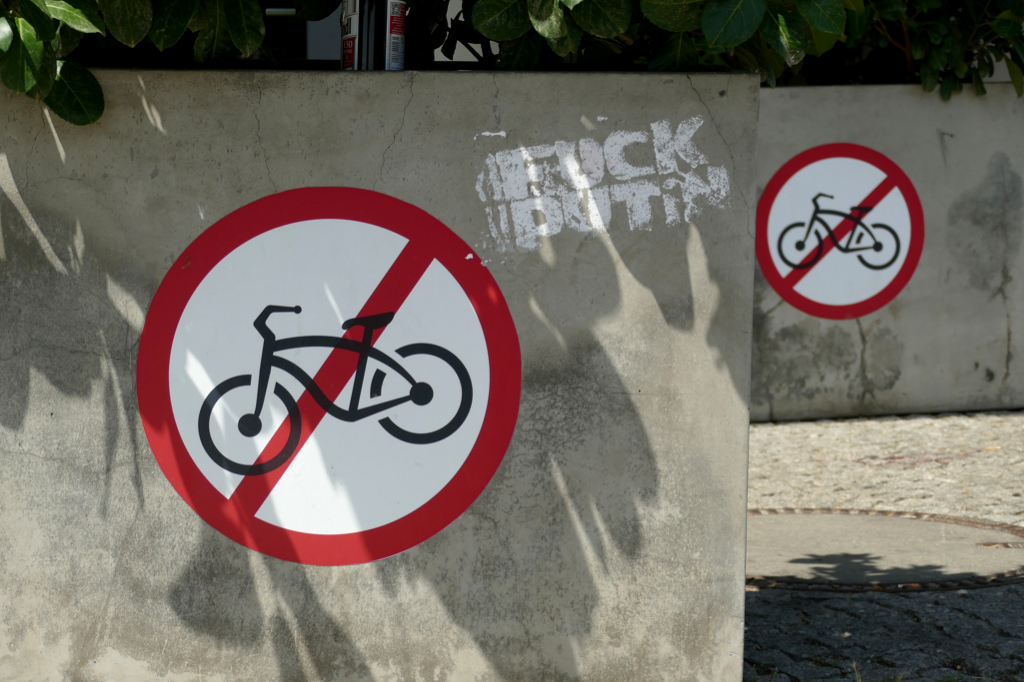
Registration is free, however, you need to create an account with a starting credit of 1€uro. Then, you can pay by credit card, debit, your mobile phone account, or PayPal. For a monthly fee of 10 €uros, you get 30 minutes per rental free. Berlin is huge, but there are many nextbike stations around town. Therefore, if you play your cards right and give your bike back in time, you probably won’t pay more than your monthly fee.
However, if you do not want to pay a monthly fee, the rate is 1 €uro for 15 minutes. Therefore, I presume that even if you’ll explore Berlin cycling for only one single day, paying the monthly fee is a far better deal, obviously.
Just Can’t Get Enough?
What? This list isn’t long enough for you? You want to discover more murals and learn the stories behind them? Then get the free About Berlin App.
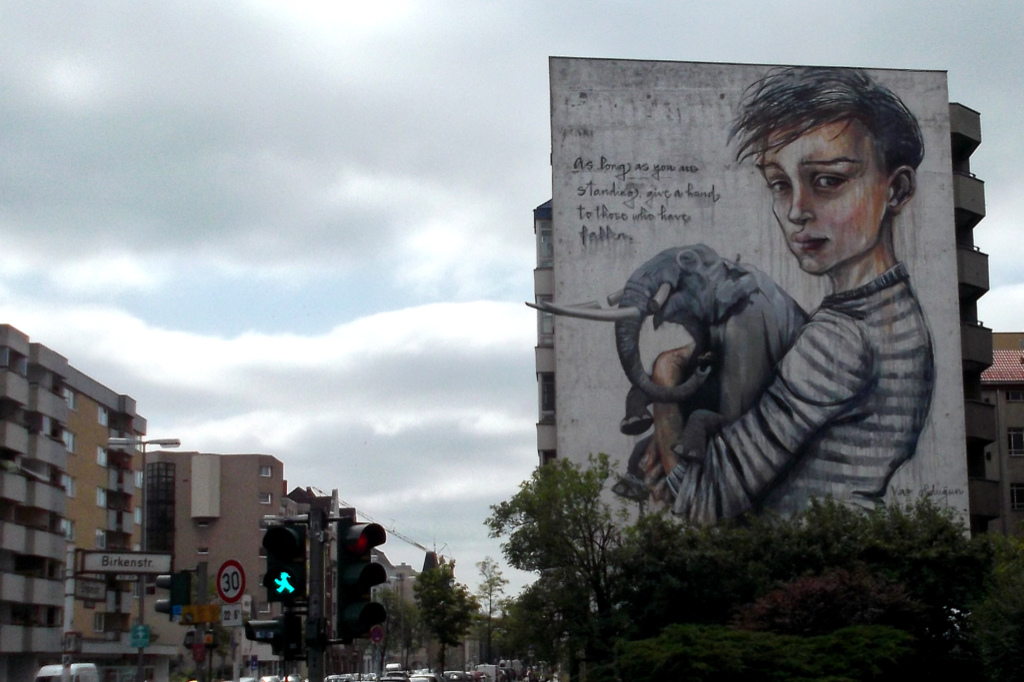
There you’ll get street art tours including directions, videos, and informative audiobooks. This way, you’ll enjoy listening to explanations on details while immersing yourself in Berlin’s Urban Art.
Map
This map should help you to find the murals I’m introducing in this post. Clicking on the slider symbol at the top left or the full-screen icon at the top right will display the whole map including the legend.
Searching for Street Art was only one of many amazing activities on my visit to Berlin. To read about the rest, go to this comprehensive guide! Also, in my post All you need to know before going to GERMANY, you’ll find further valuable information that will make your own trip much smoother and more enjoyable.
Pinnable Pictures
If you choose to pin this post for later, please use one of these pictures:

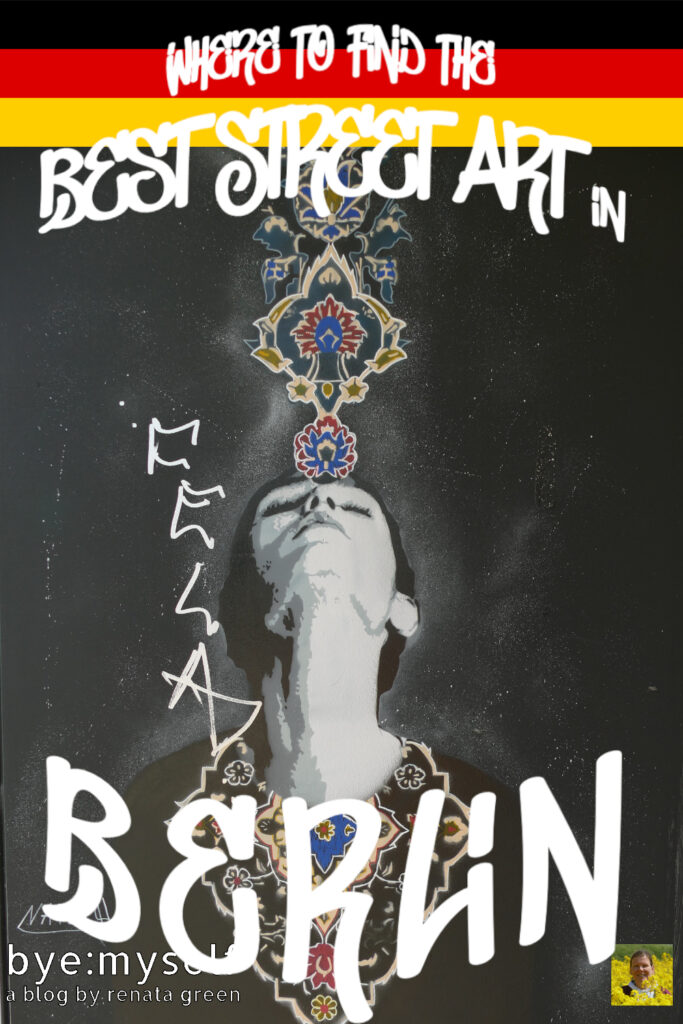
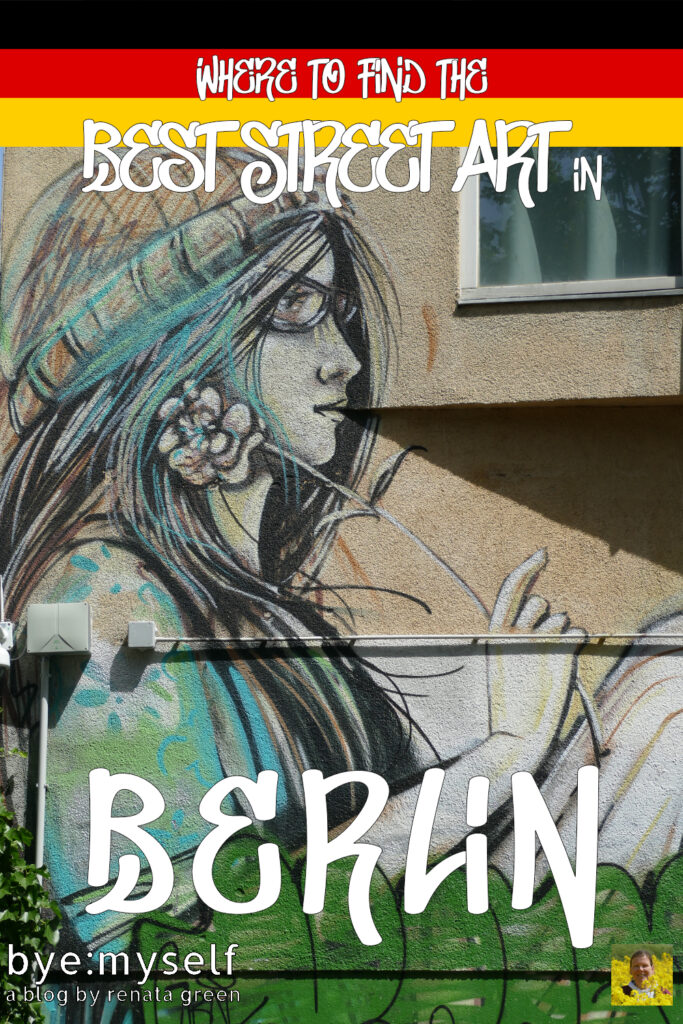
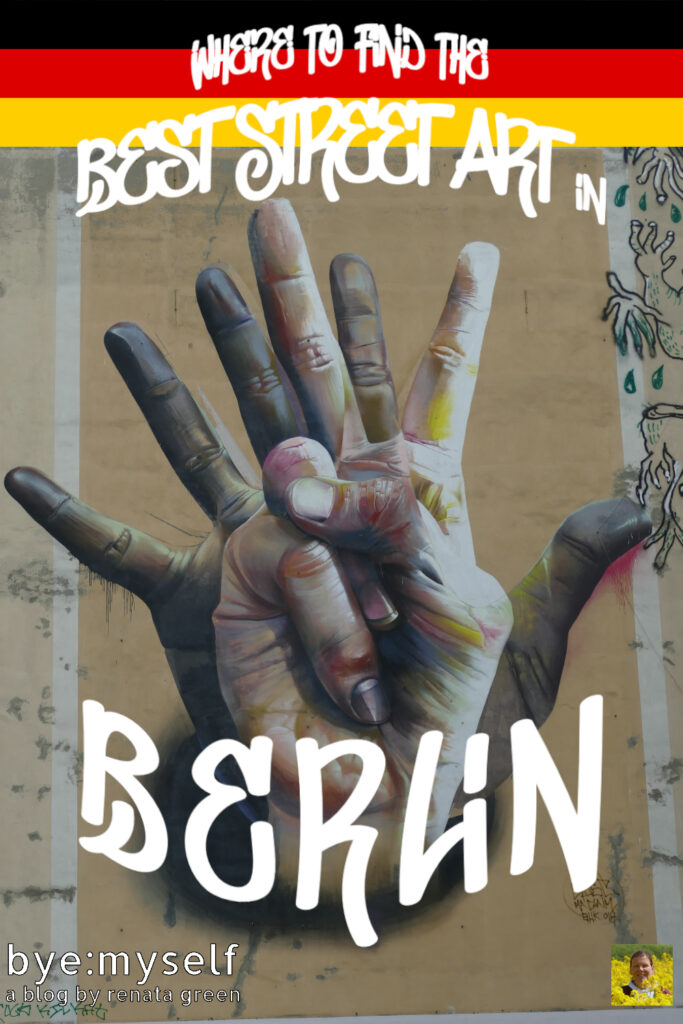
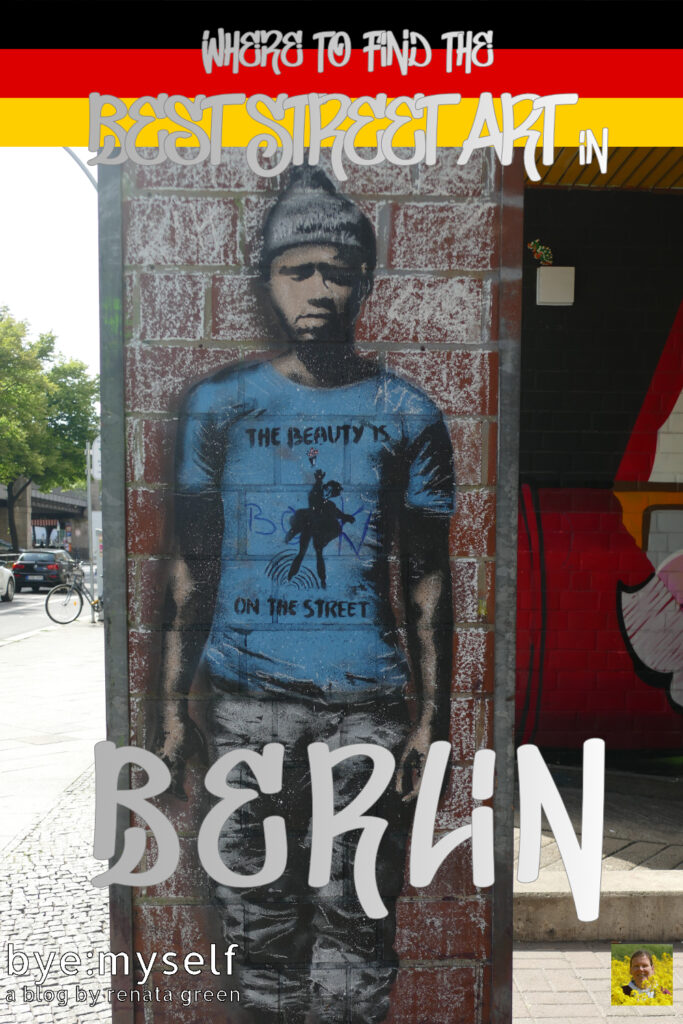

Did You Enjoy This Post? Then You Might Like Also These:
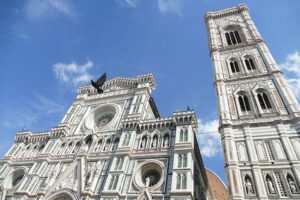
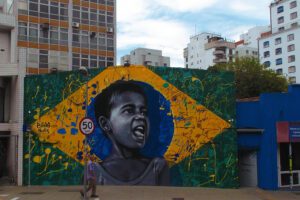
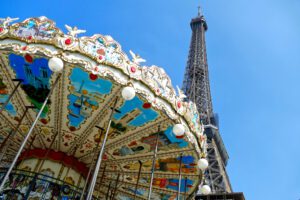

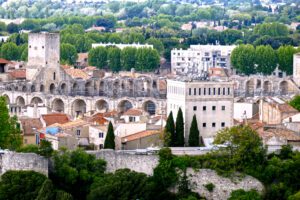
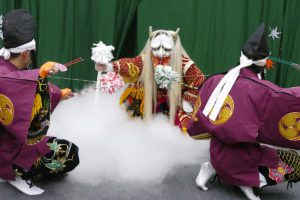

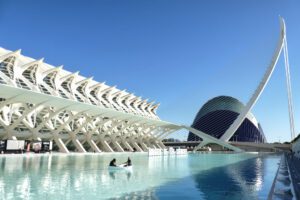
You ought to take part in a contest for one of the finest websites on the internet. I will highly recommend this web site!
Thanx, that’s very sweet of you!
The unique and varied street art is almost overwhelming. The talent of these individuals is inspiring. Thanks you for bringing all of this art together.
I am surprised at the different types of street art in Berlin. The art at The House which is named after Tommy Weissbecker is particulary stunning. So large! Berlin’s most iconic kiss mural is interesting. I have not been to Berlin yet, but when I do, I will look around the murals. 🙂
I love the great variety in street art you found in Berlin. I it is fascinating to see it back to back on the buildings. Interesting to read that some pieces have been re-created. Love the blue and yellow tributes for Ukraine. Street art is definitely something we would seek out in Berlin.
Street Art is something you can hardly avoid when in Berlin 😉
Berlin has wonderful street art! We did a street art hunting “tour” there and it was SO much fun! Your post makes me want to come back to Berlin again.
I don’t blame you 😉 it’s an inspiring city 🙂
Ohh wow….I love street art & the captures shared here so amazing, I wanna do the same in my Berlin trip. Cheers